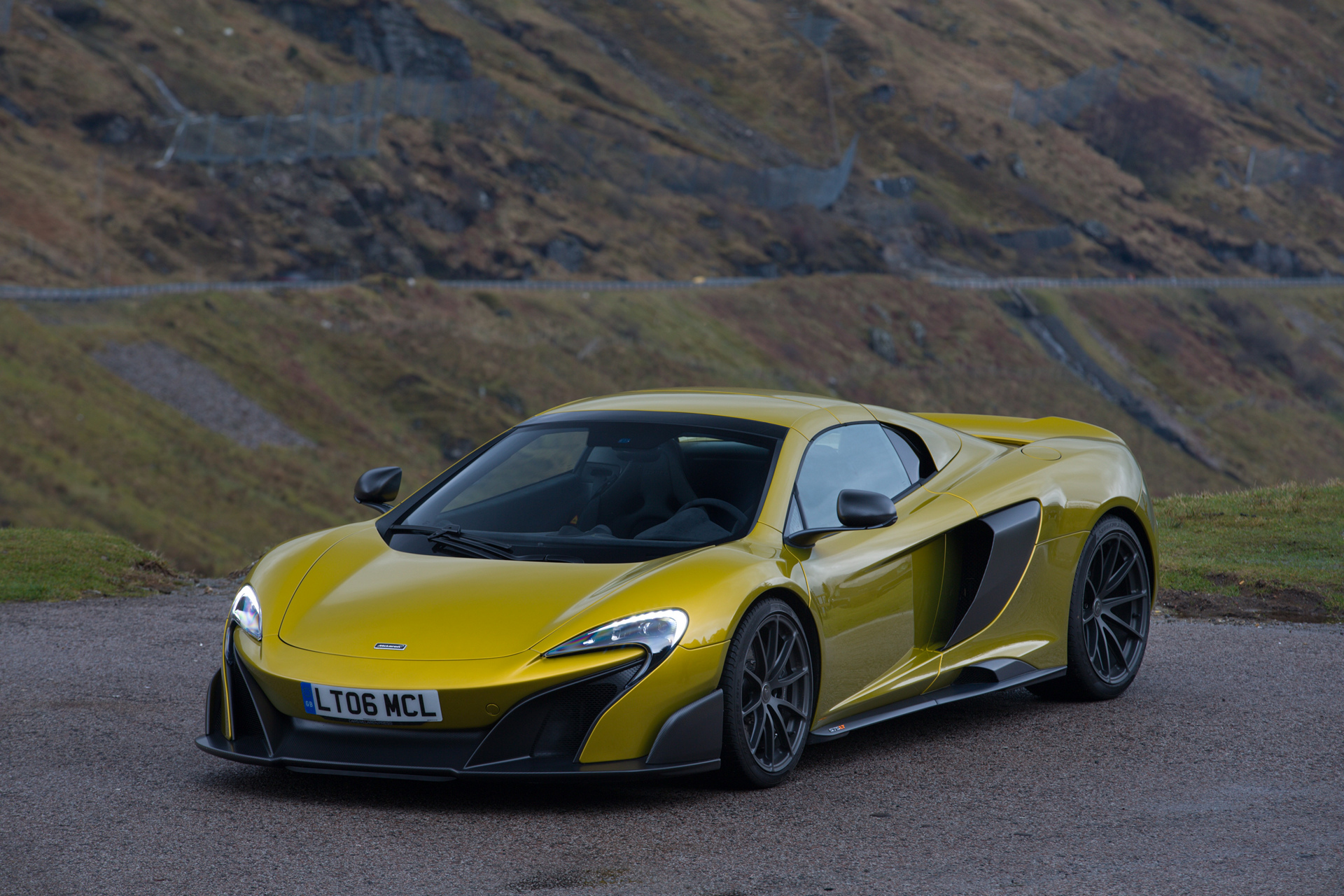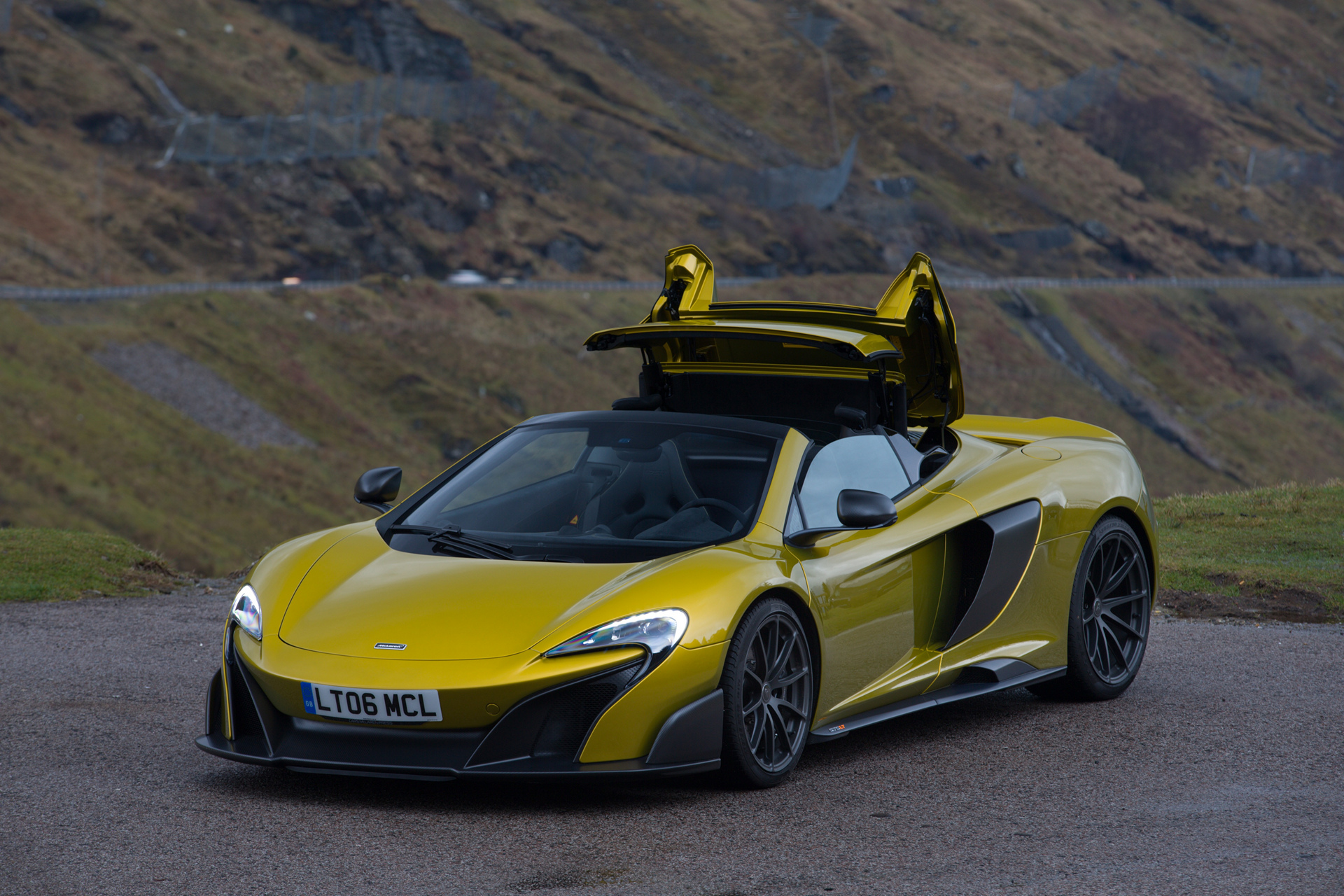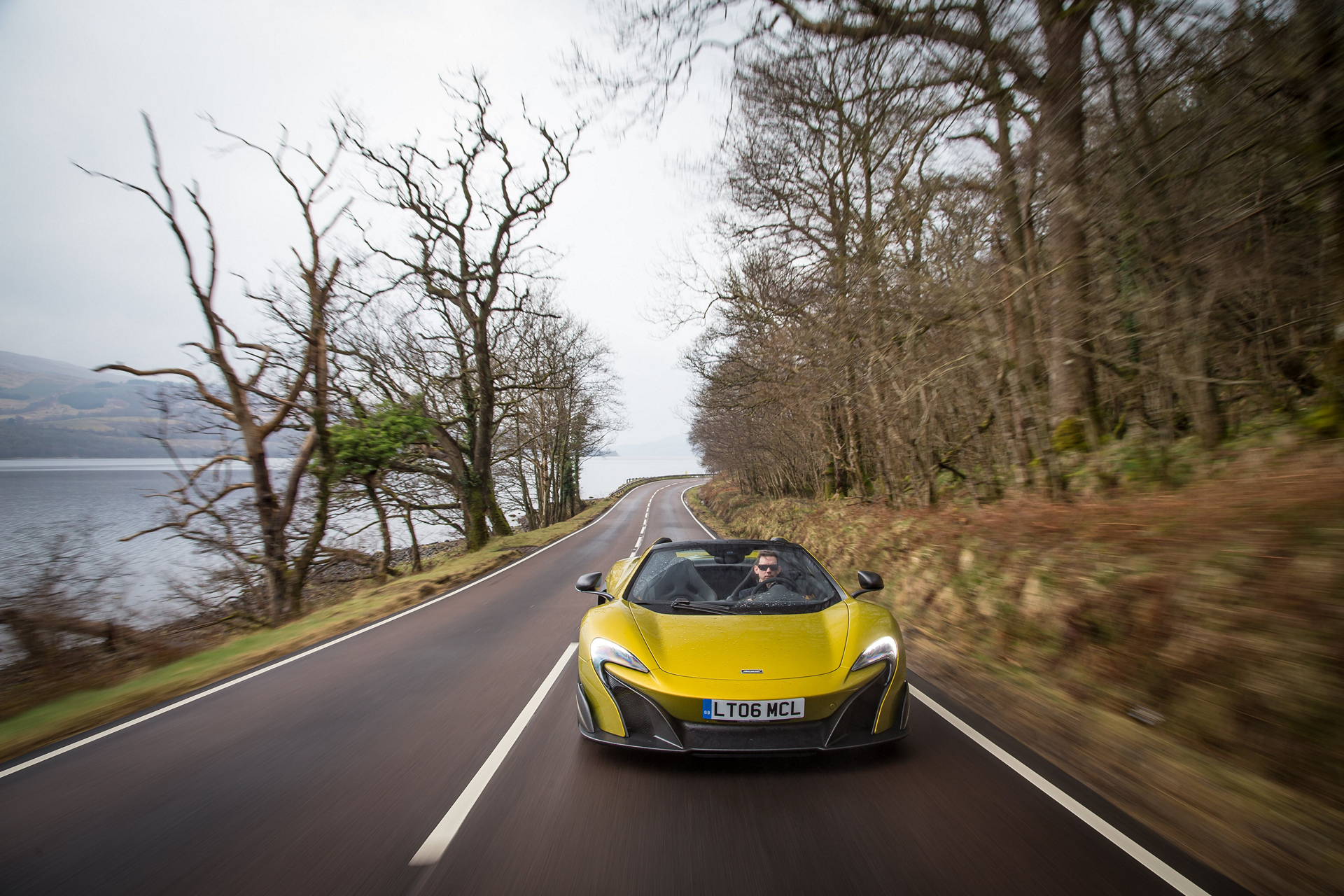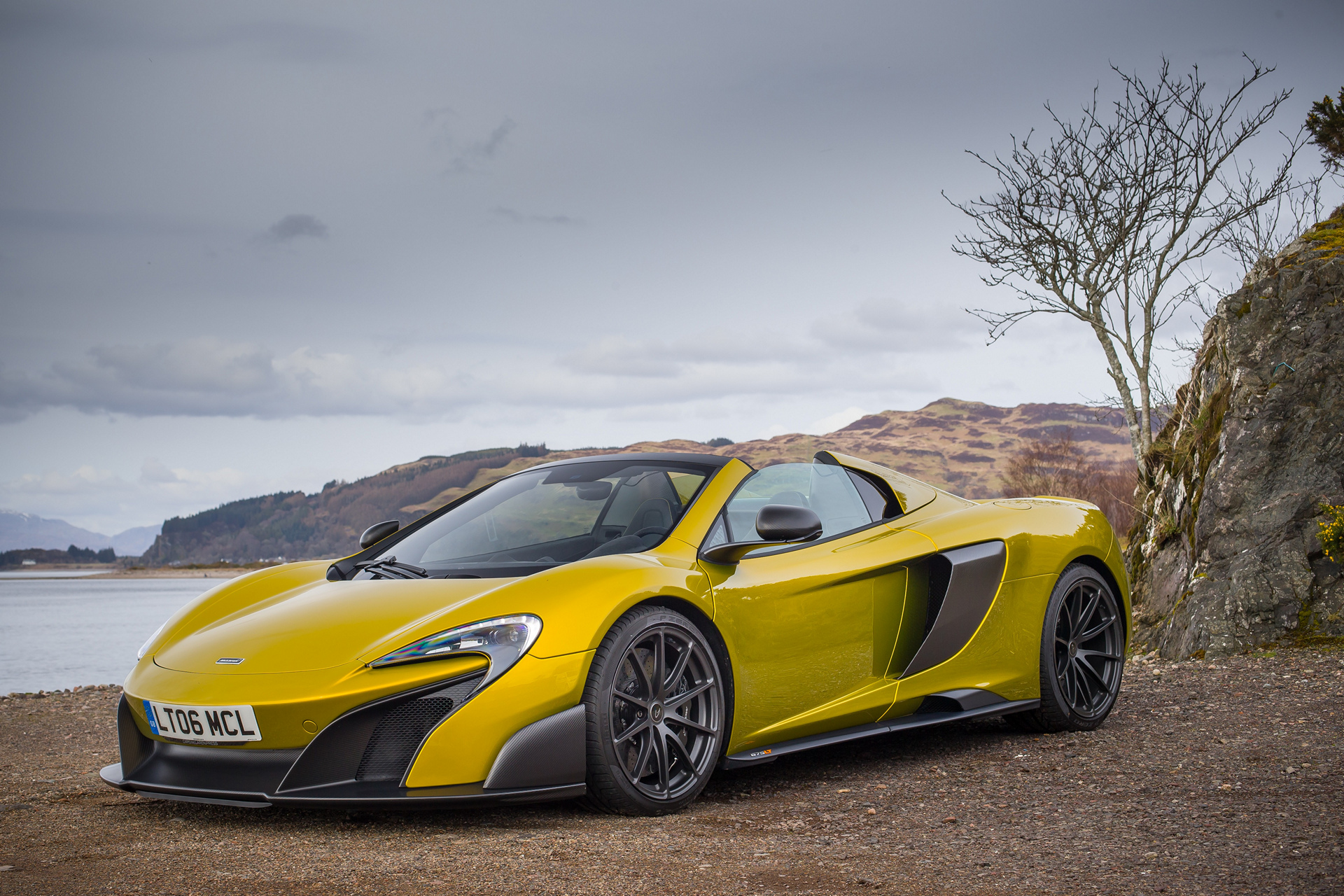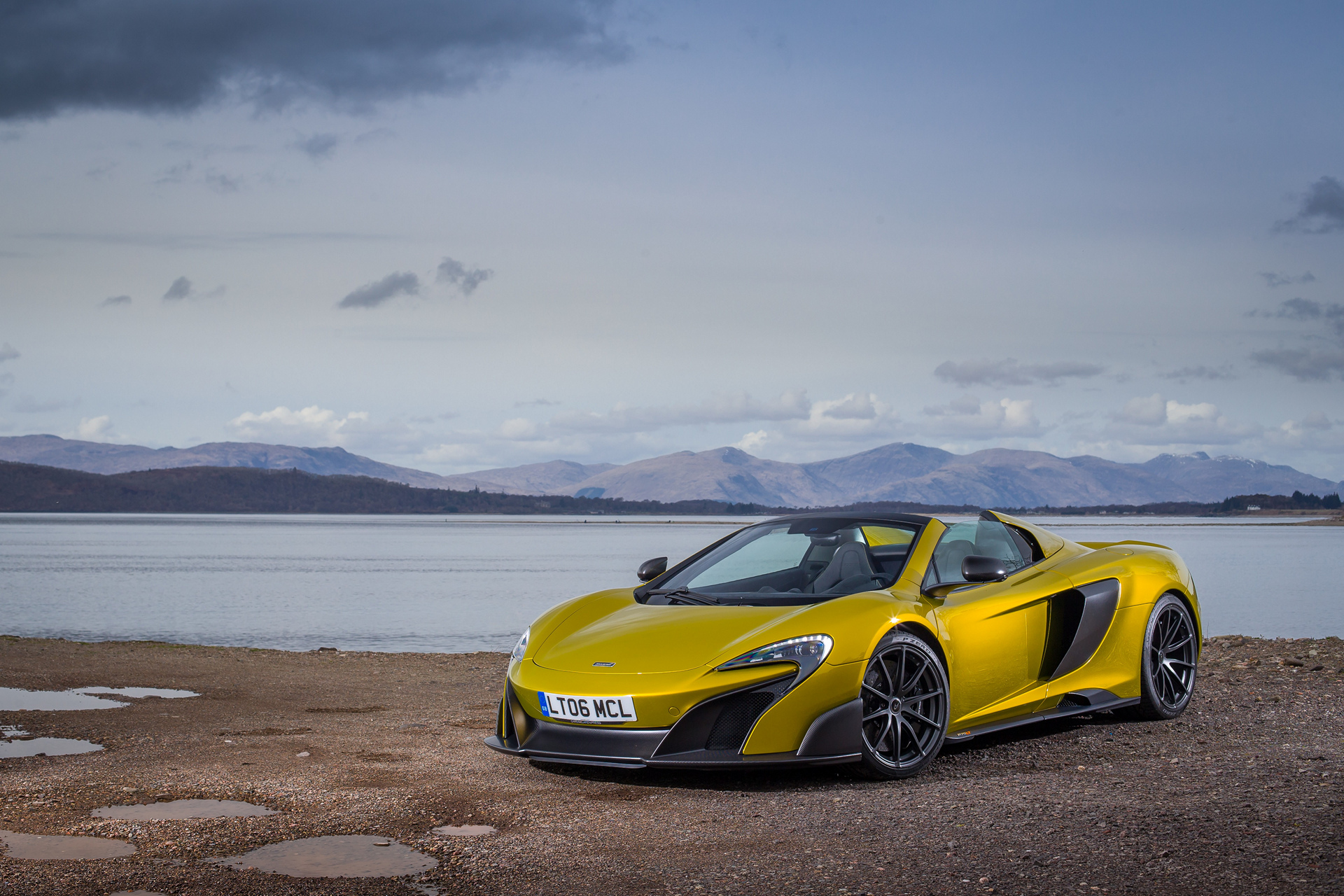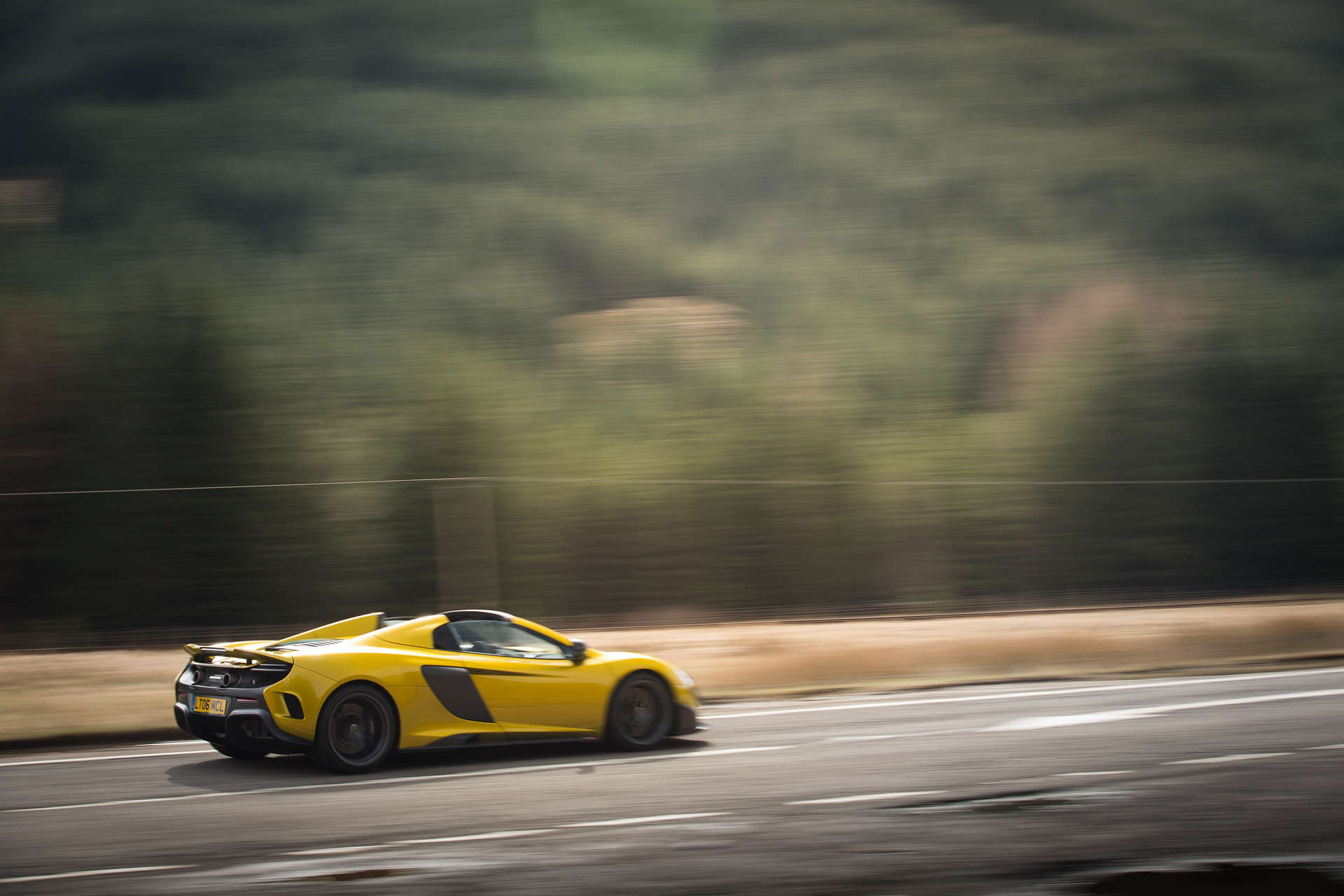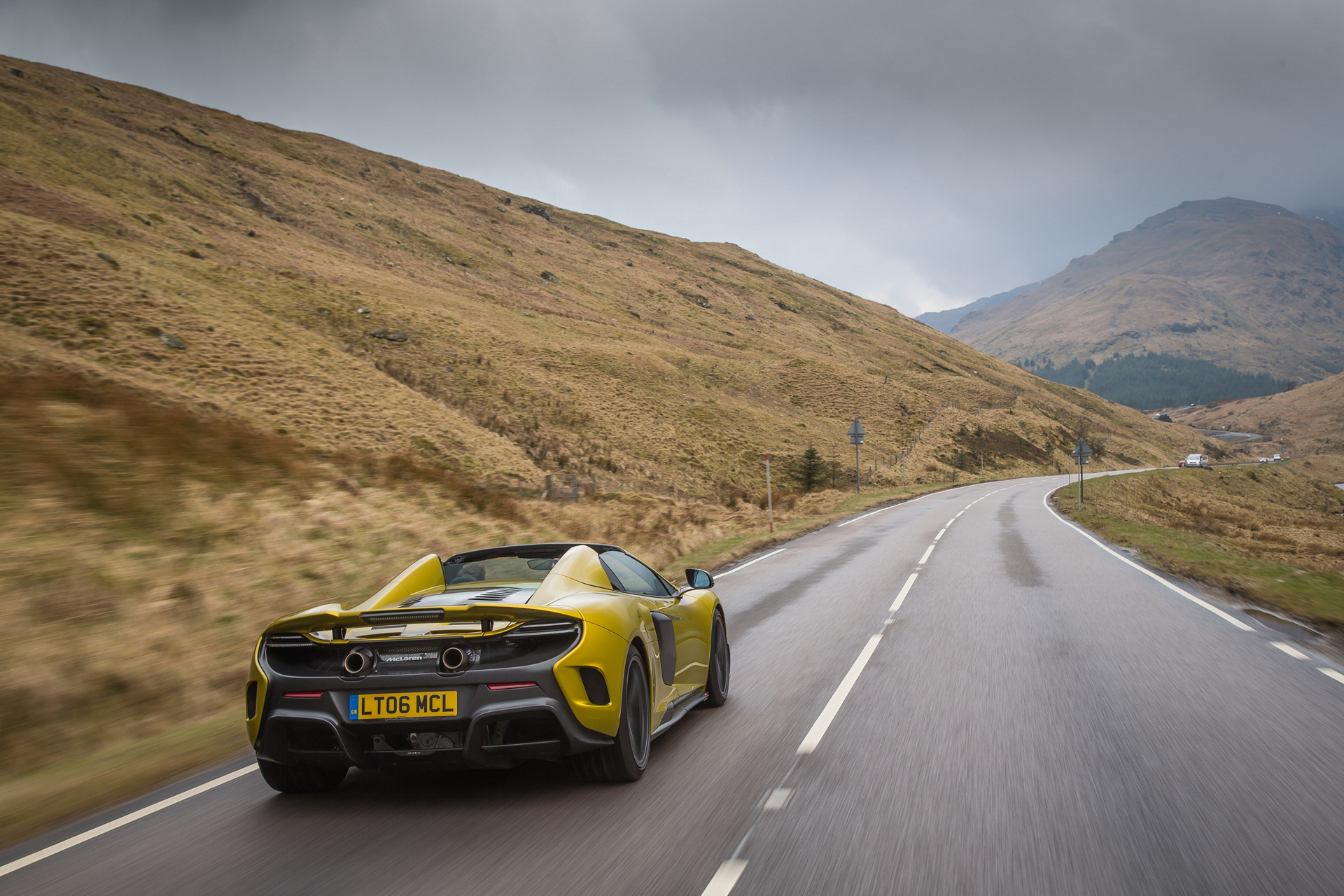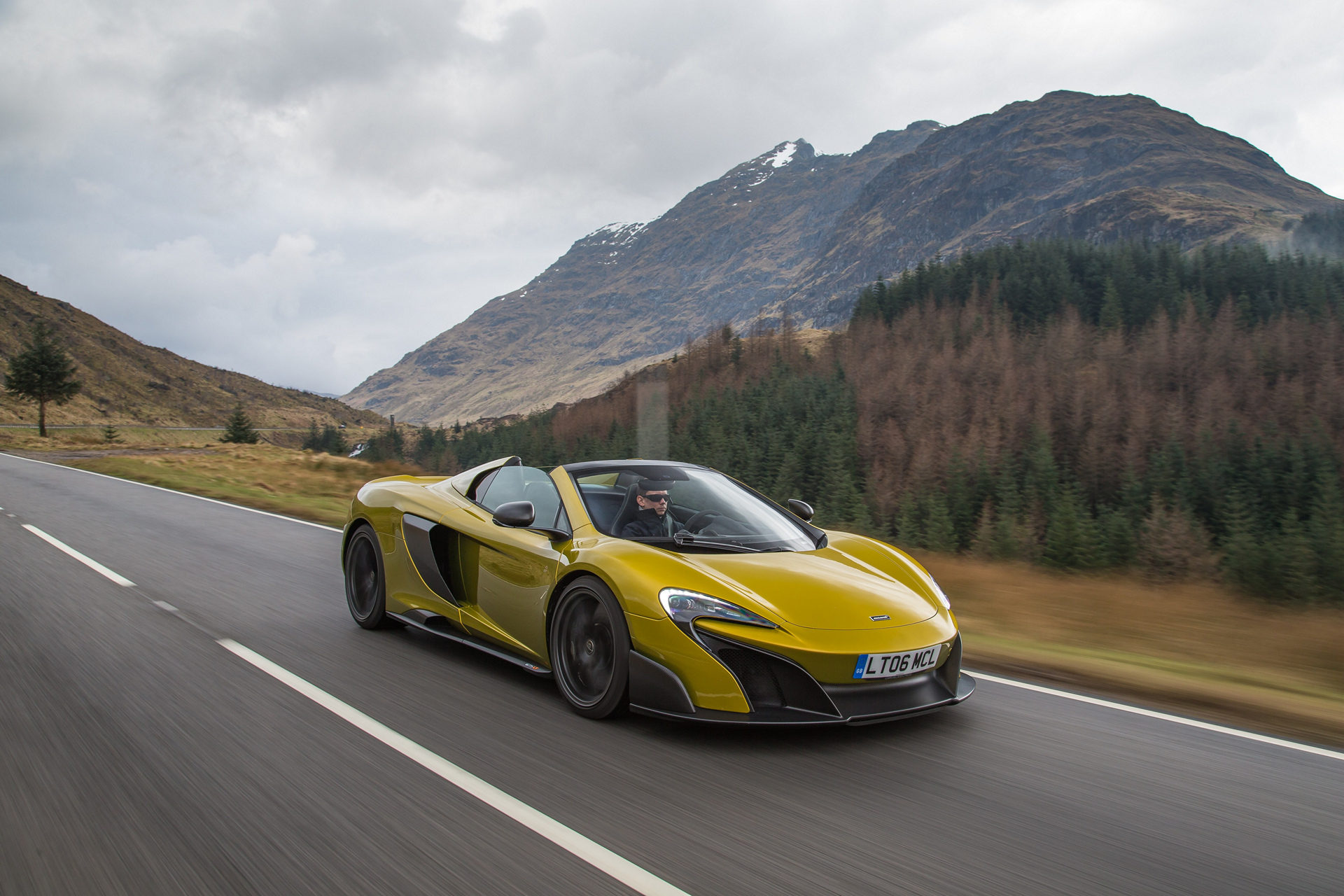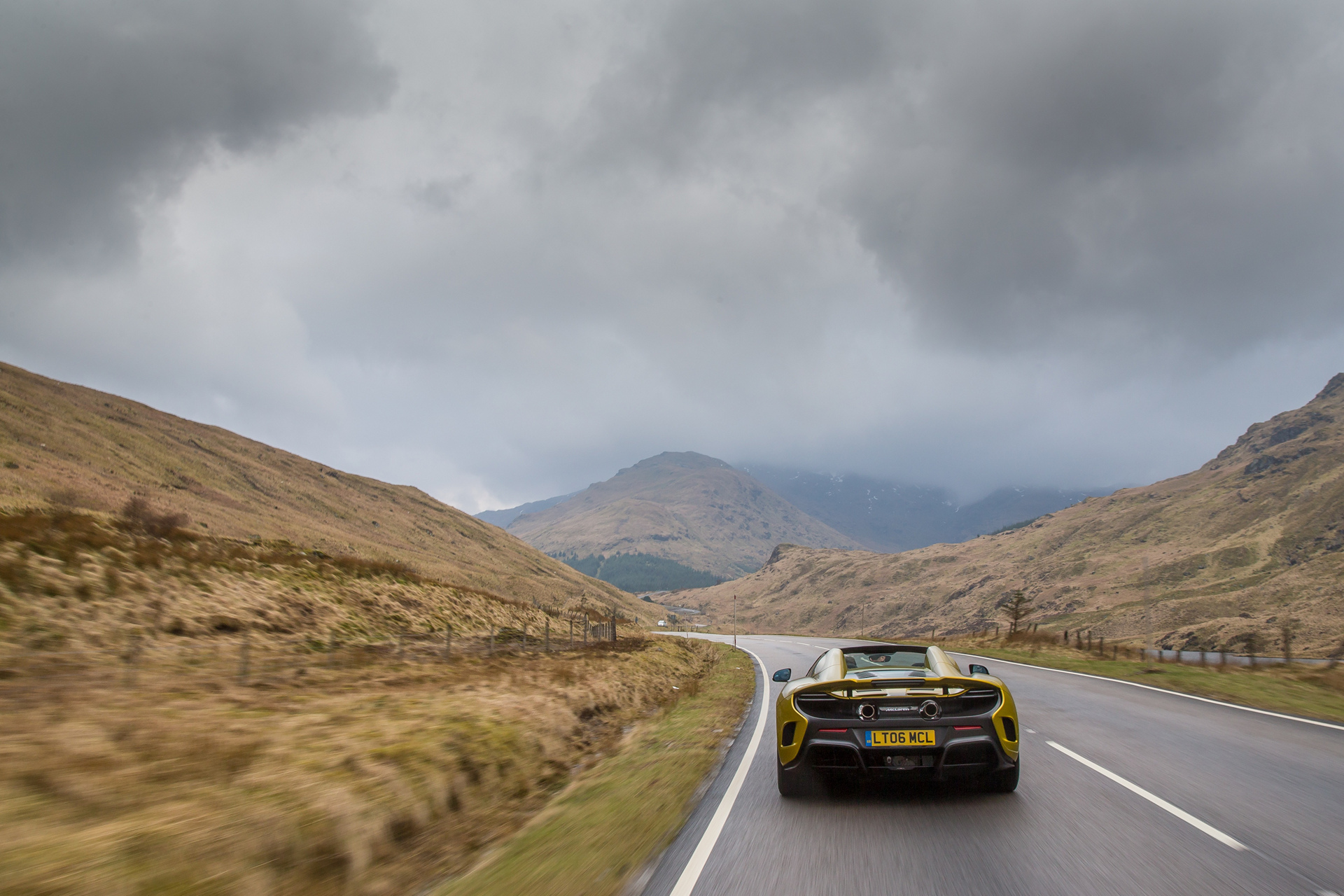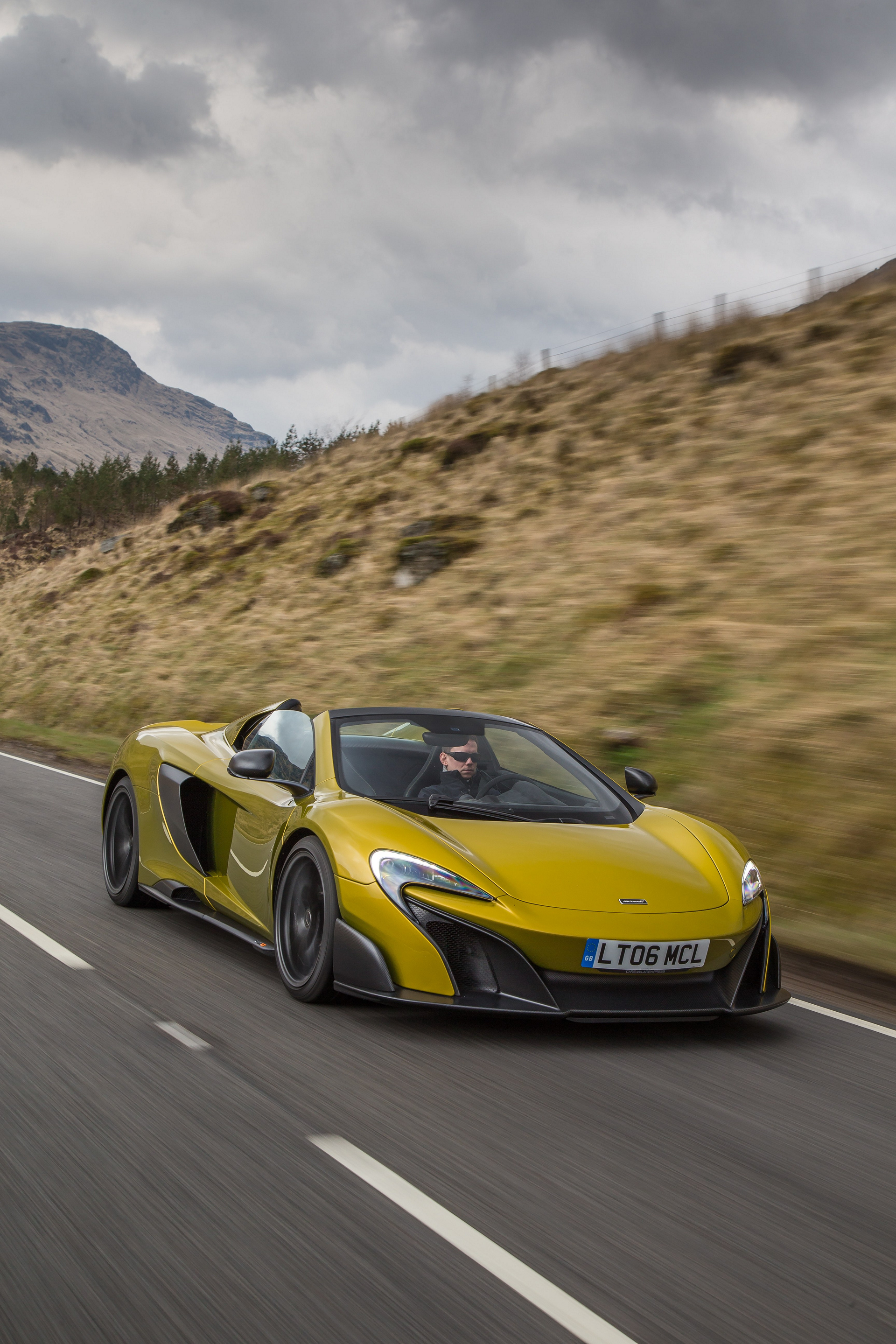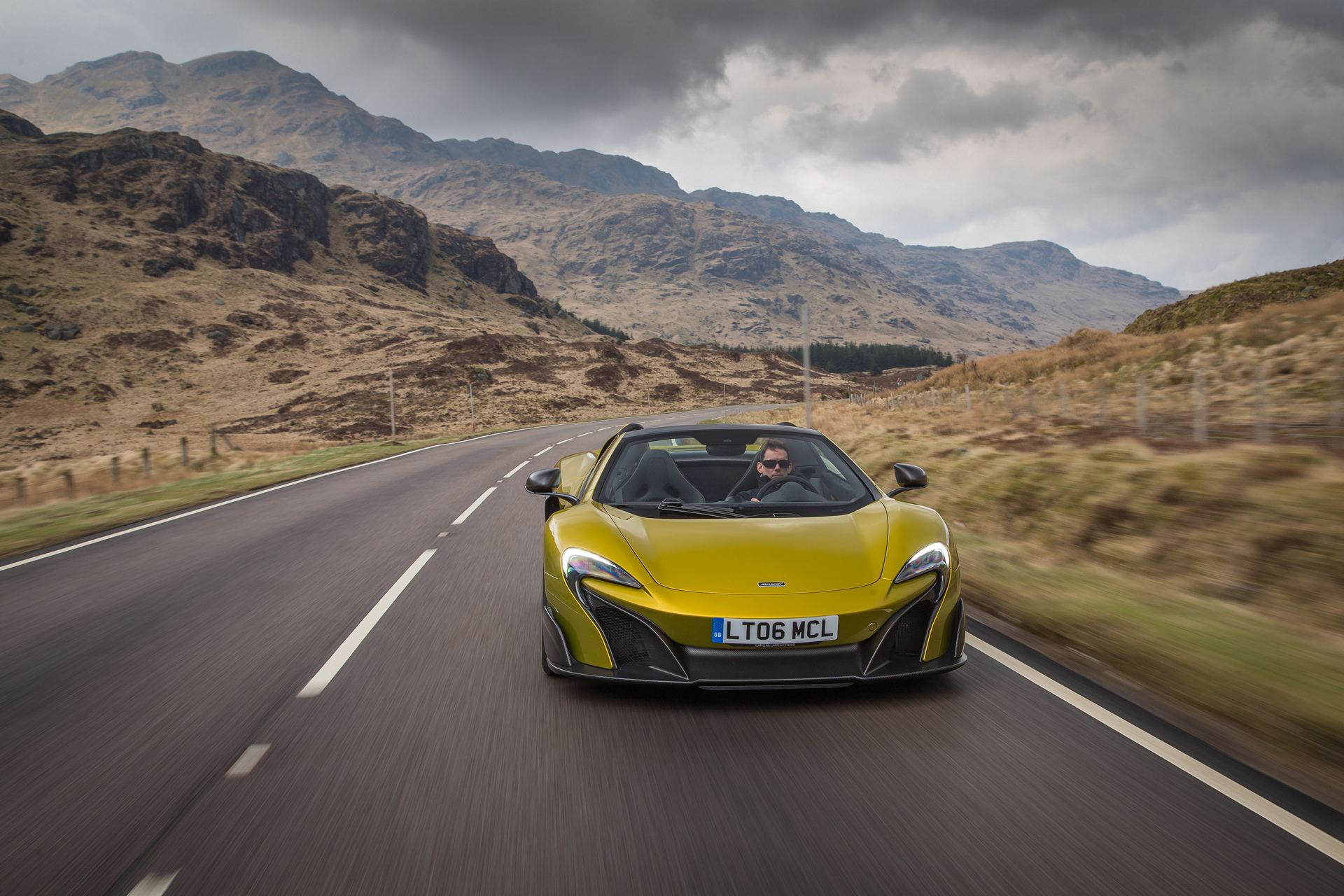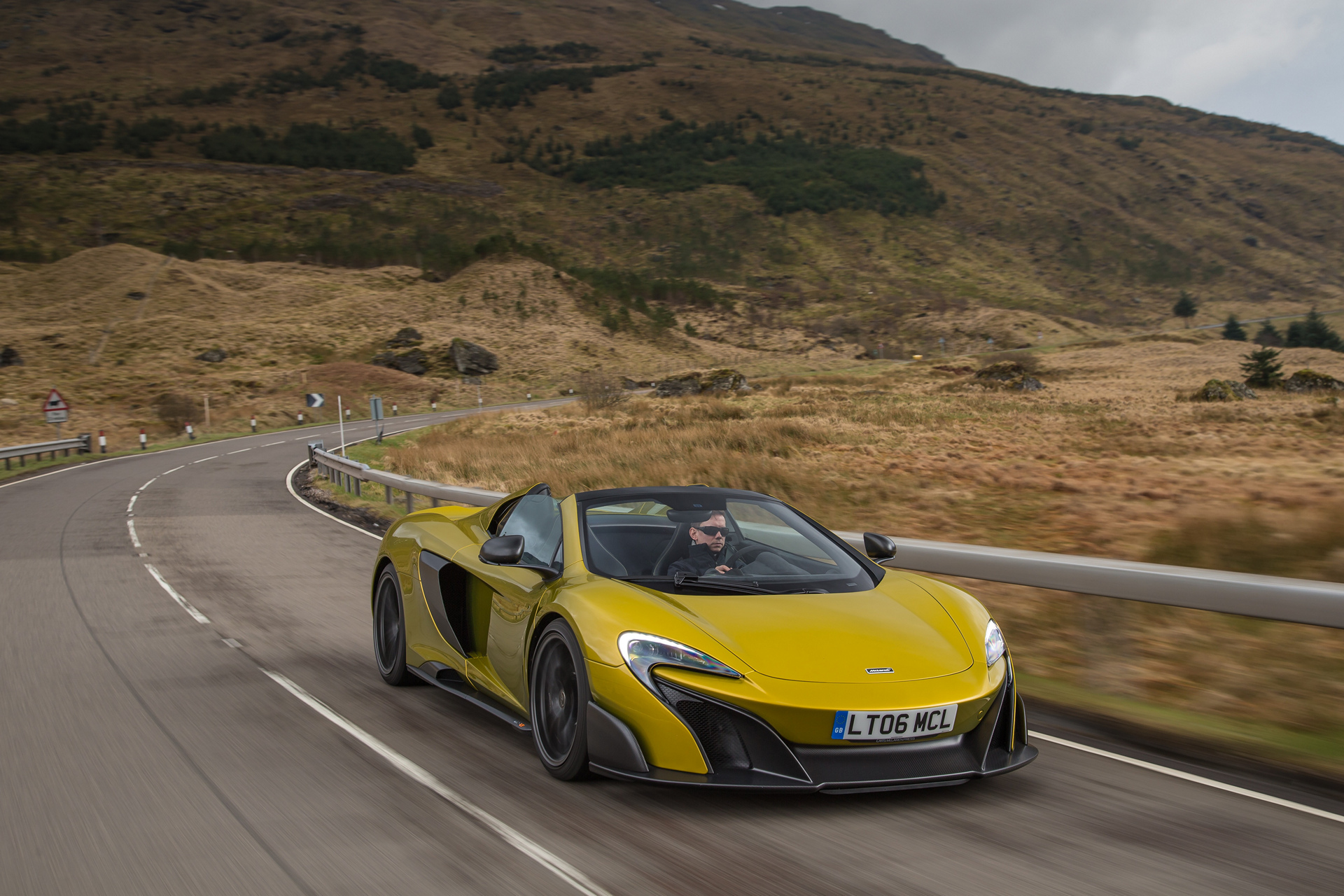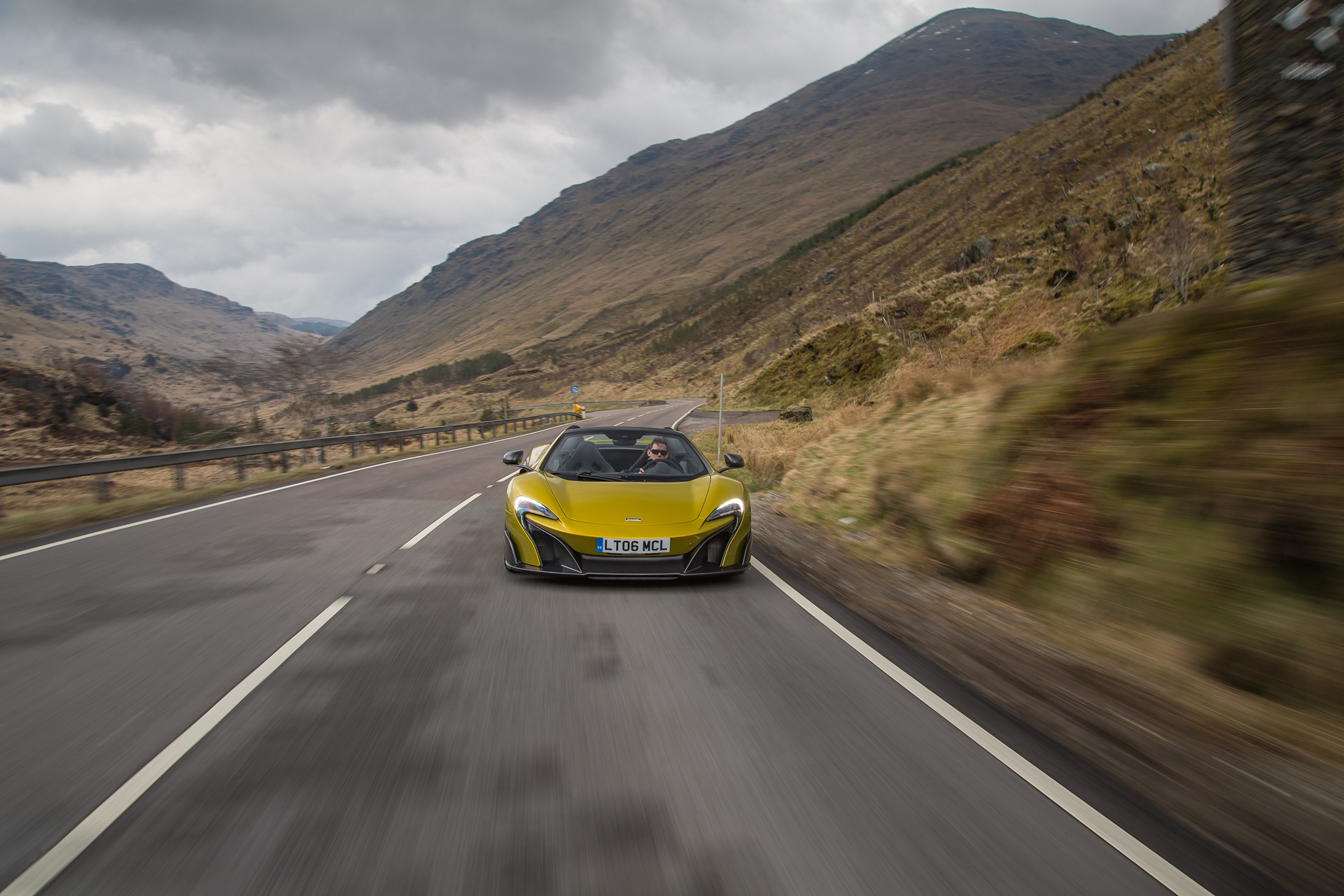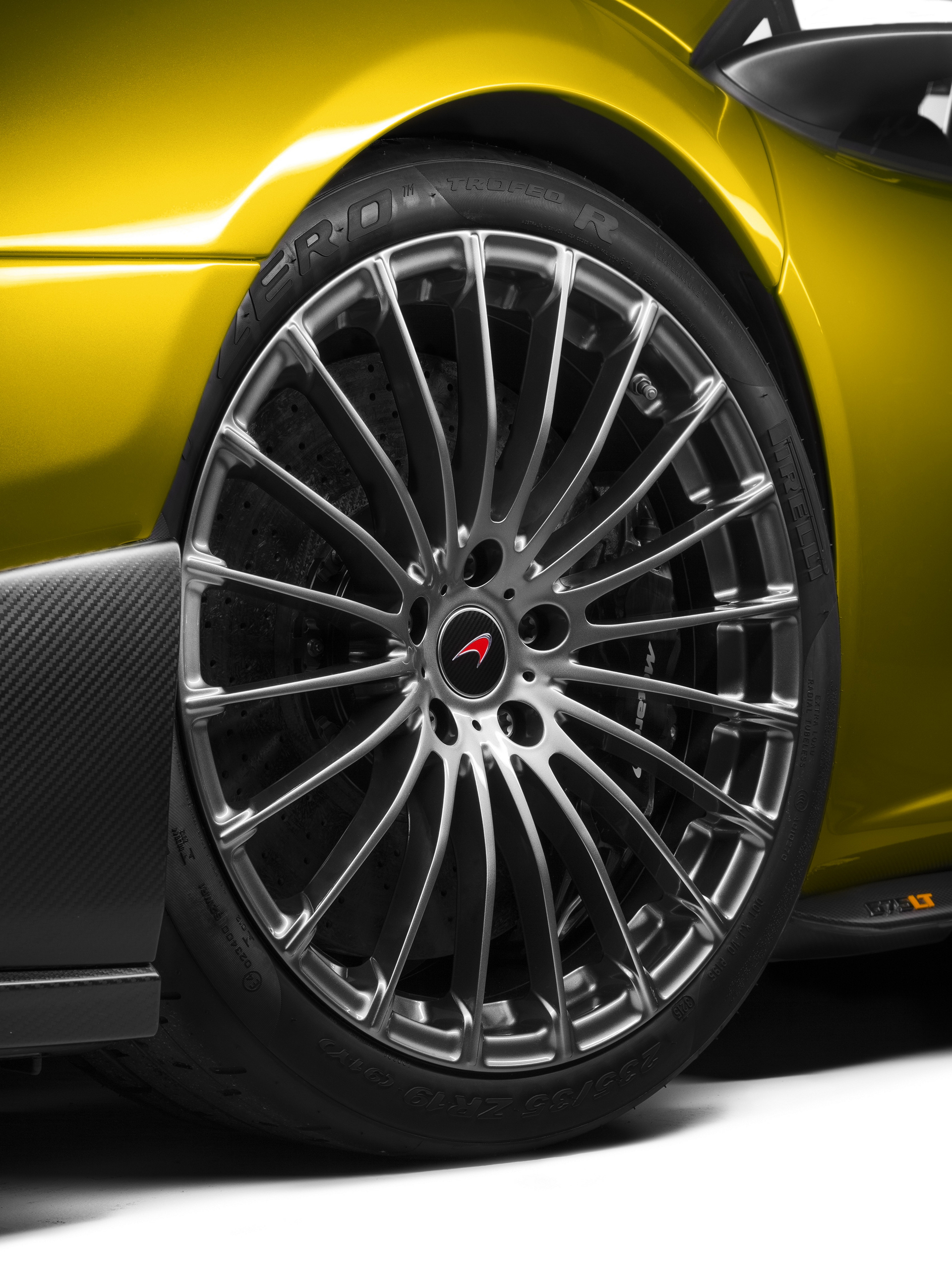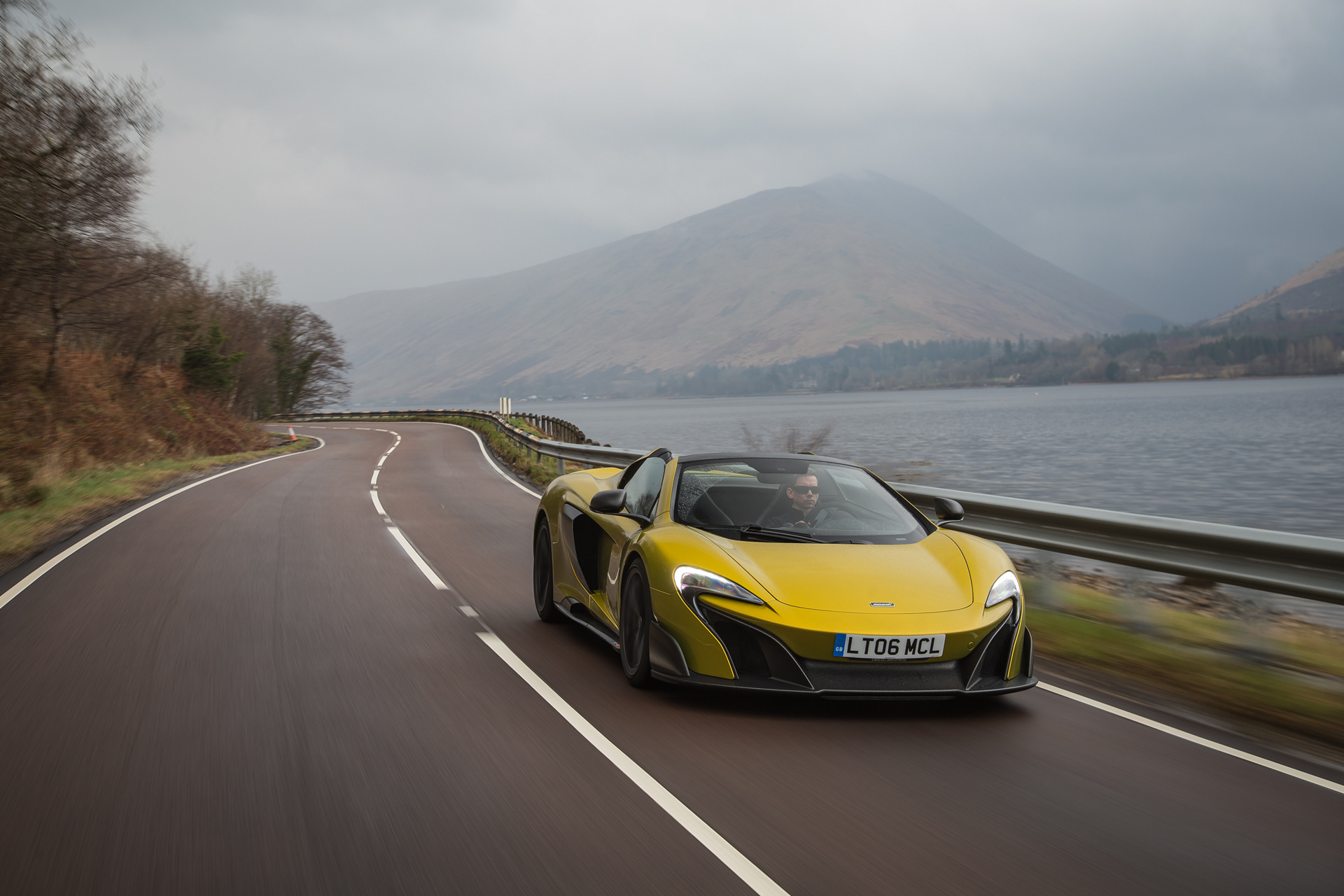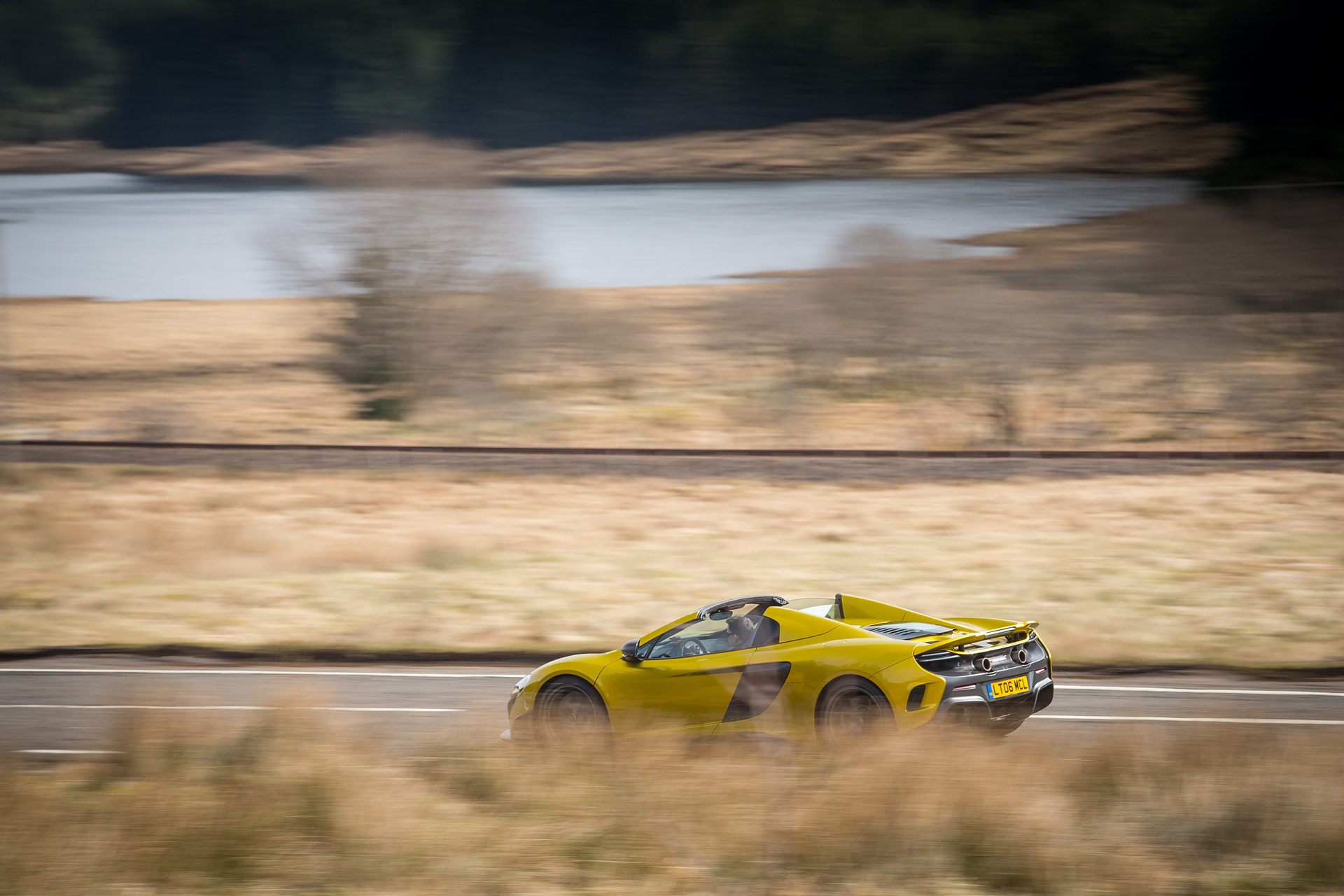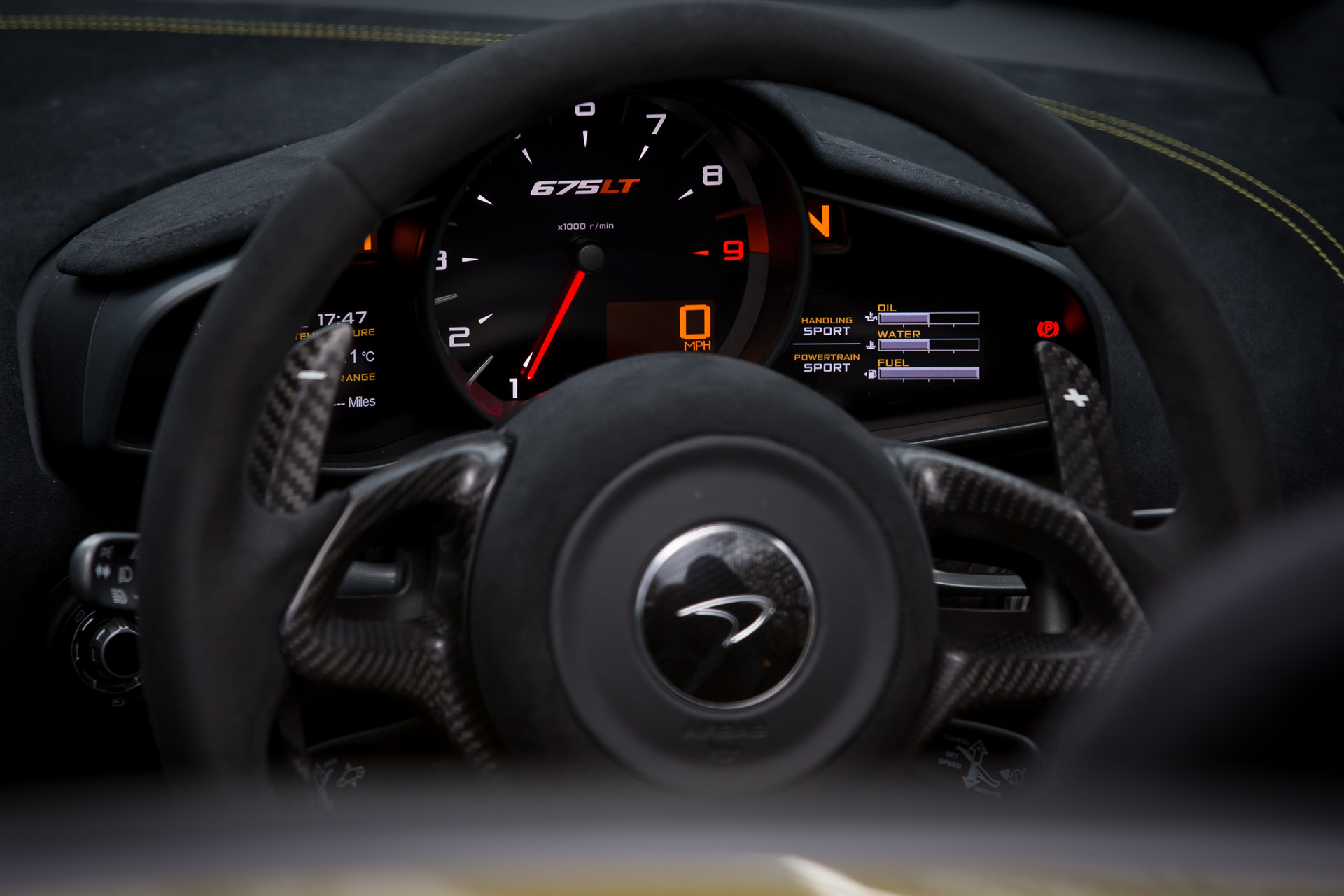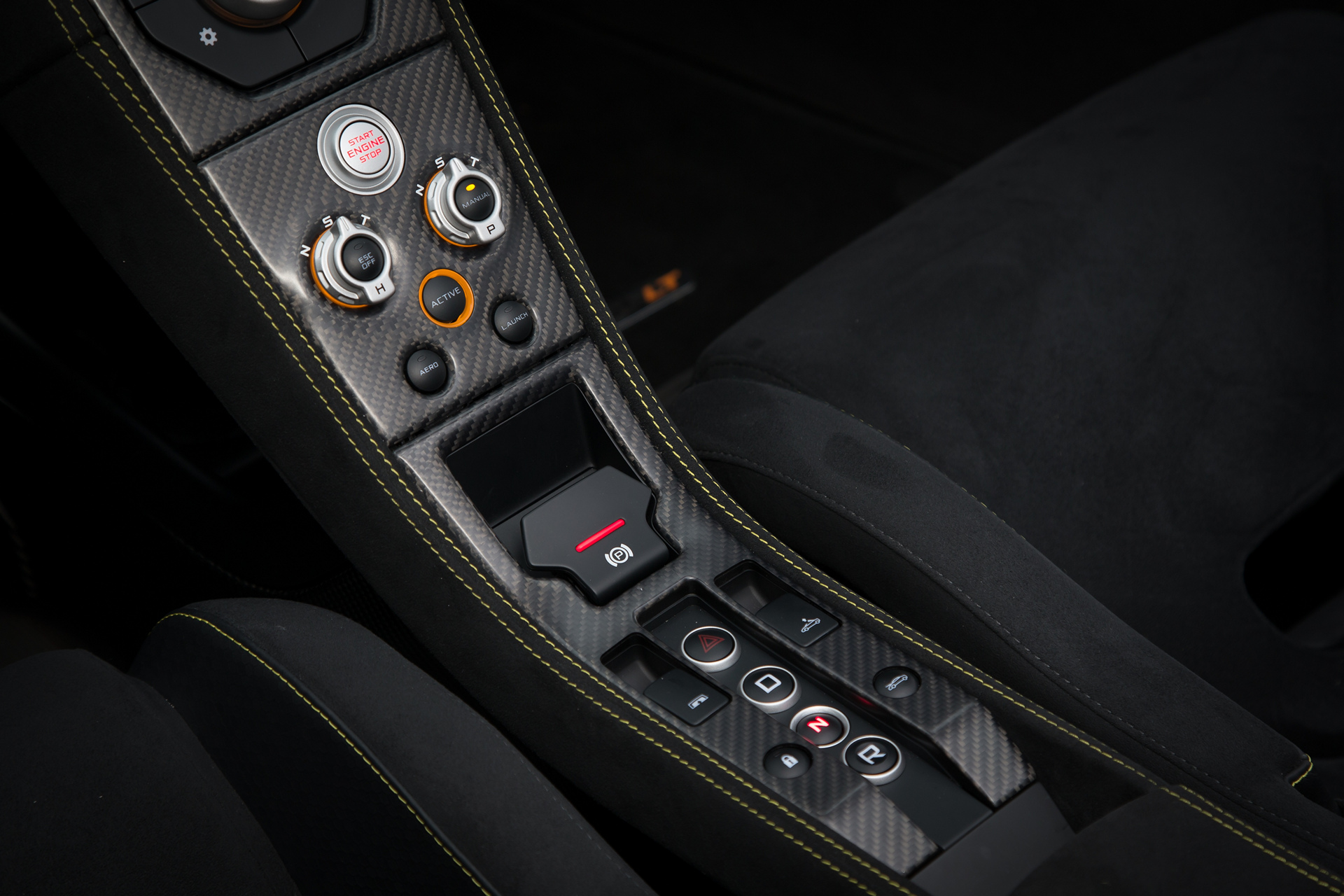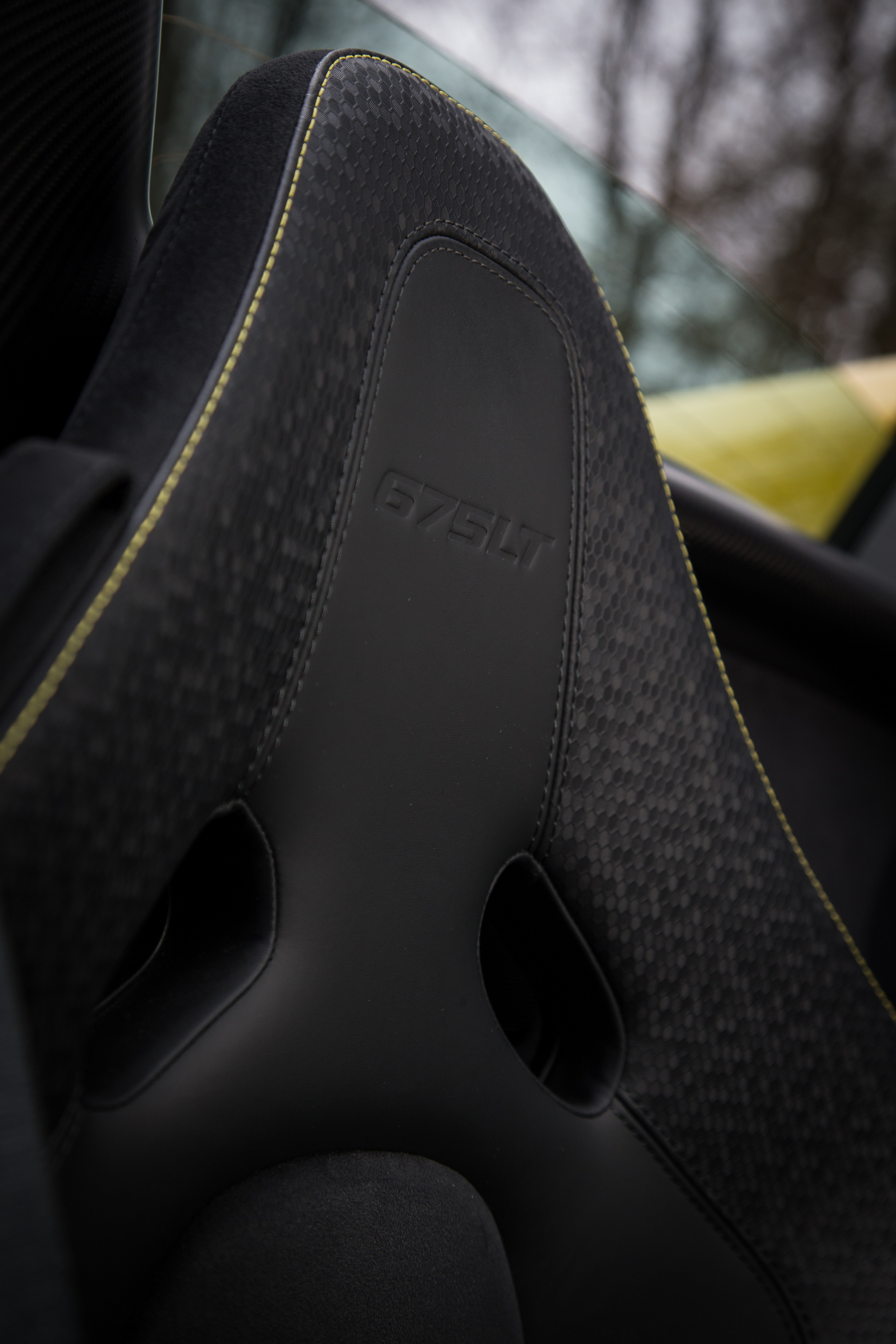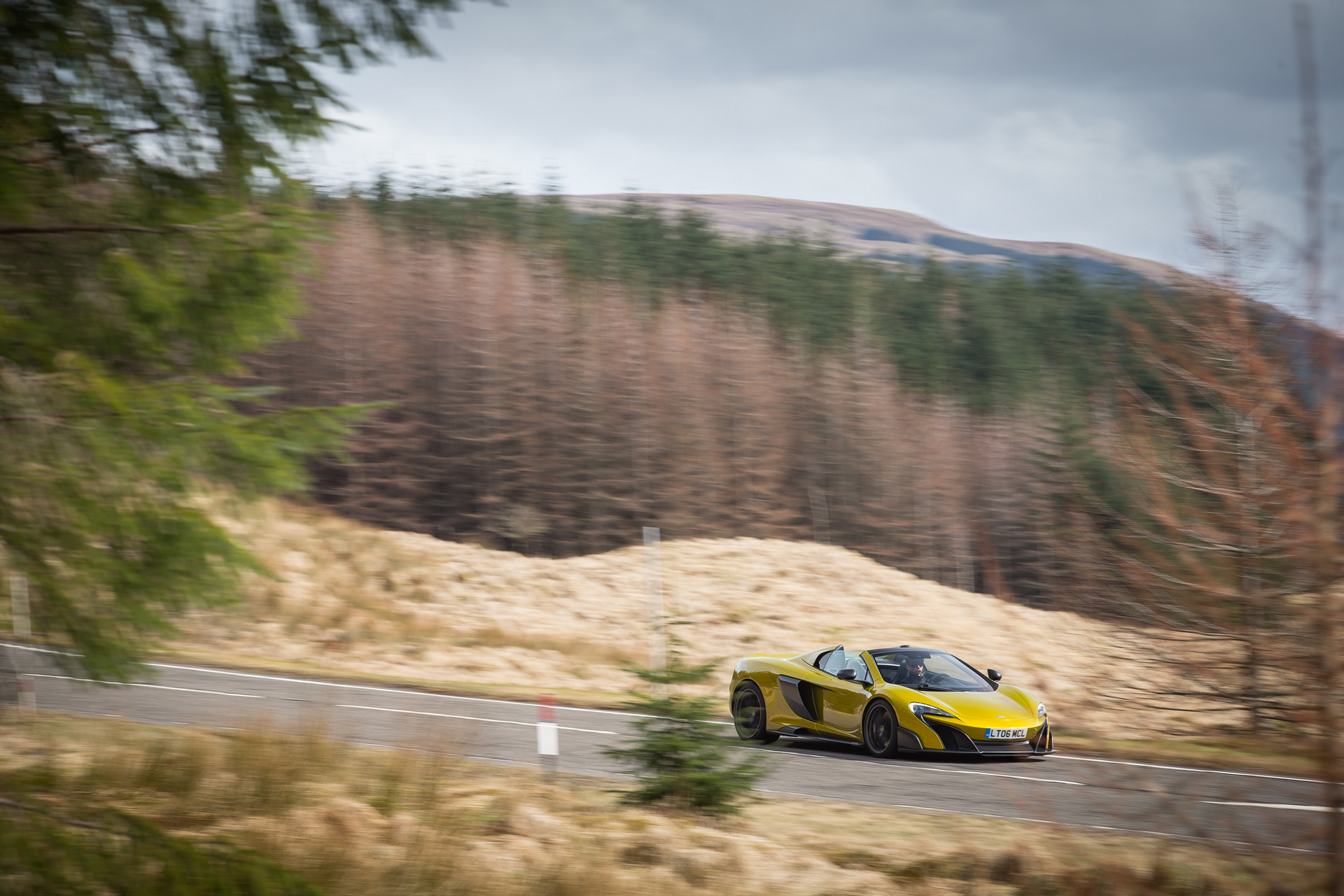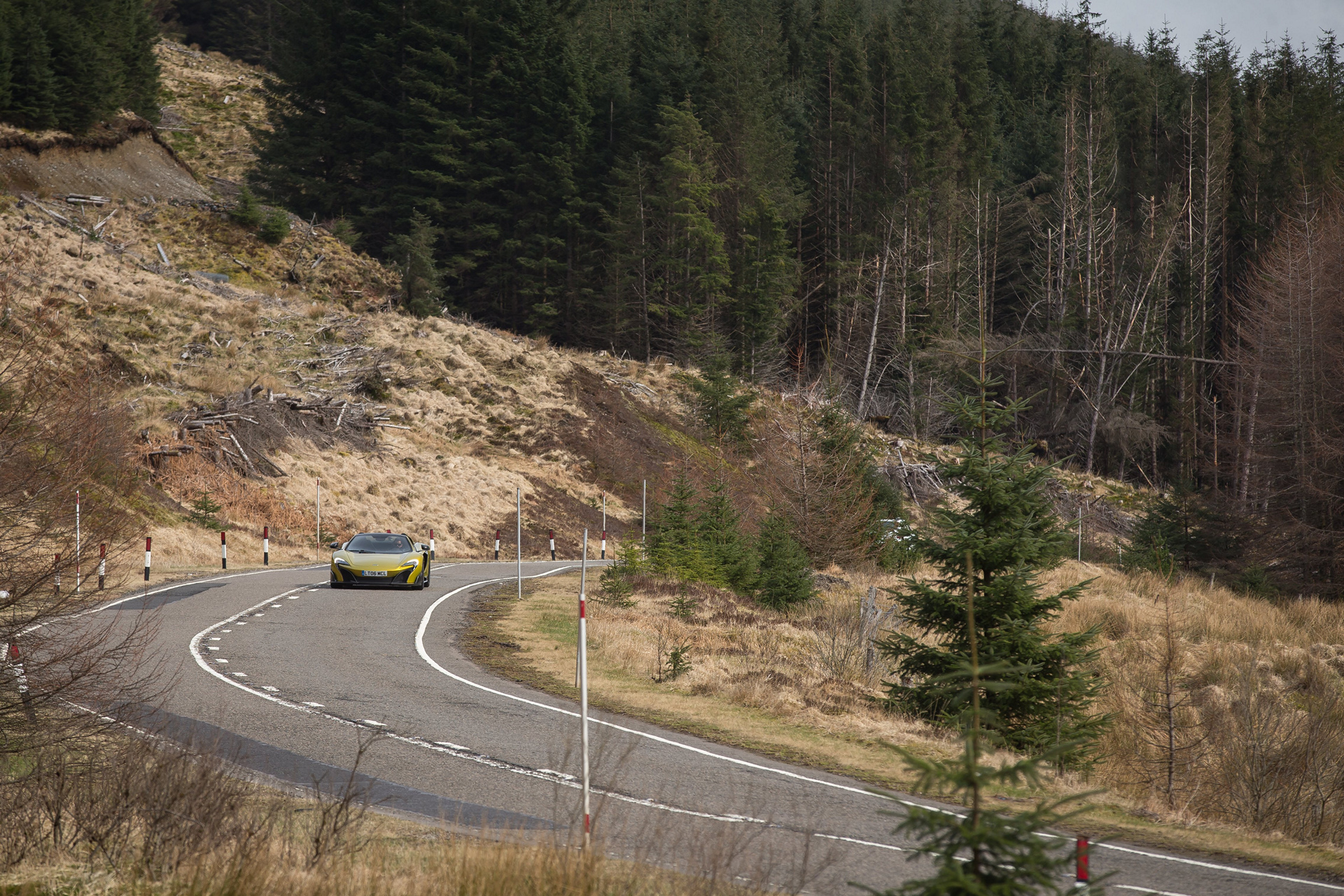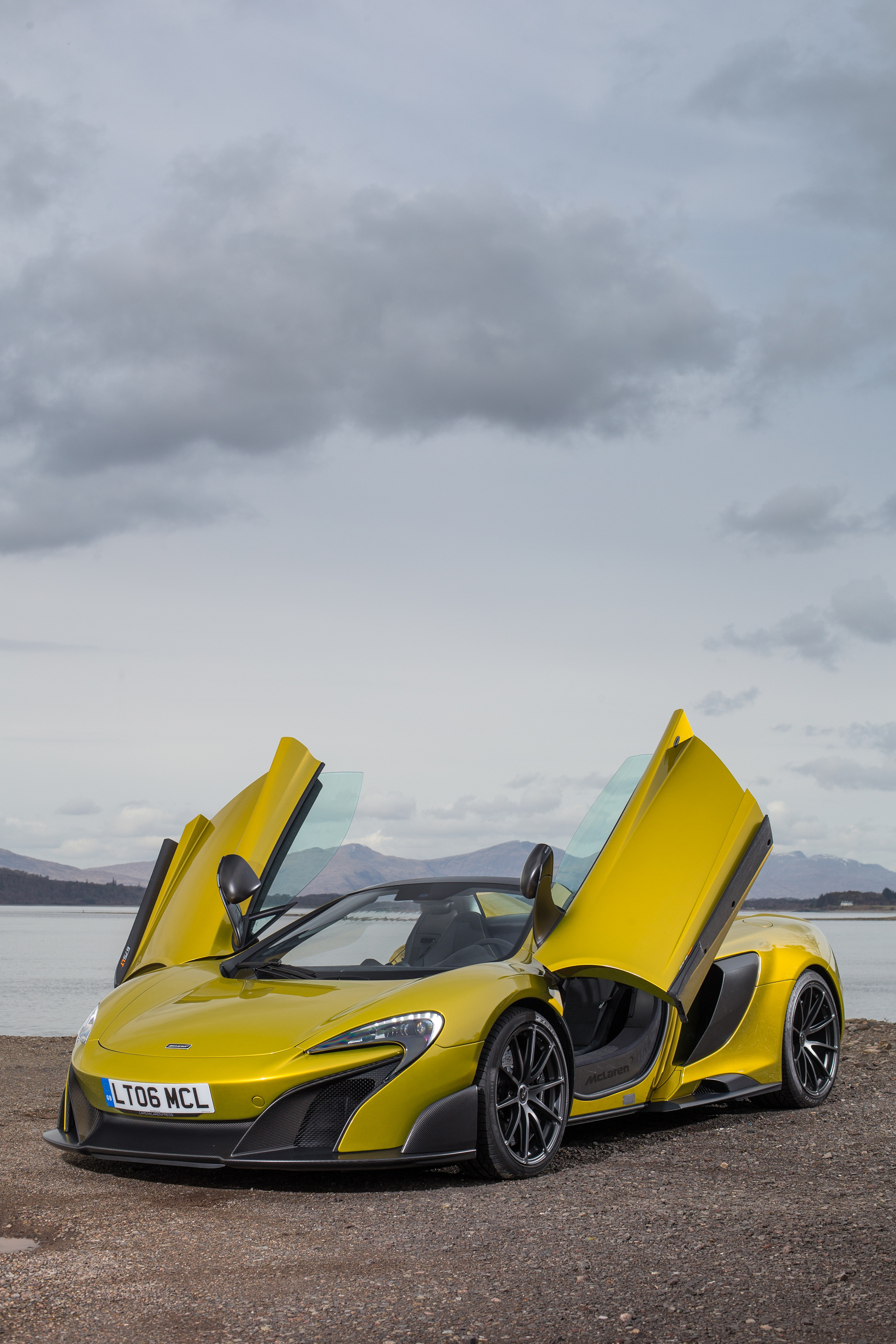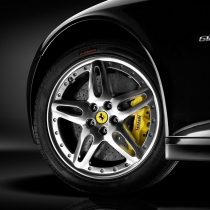The 675LT Spider was revealed at the end of 2015 as the latest chapter in the history of the iconic ‘Longtail’ name, and was the fifth new model debuted during a truly defining year for McLaren Automotive. Strictly limited to only 500 examples worldwide which sold out in just two weeks, it is only the second model to wear the LT badge. This latest model arrived less than a year since the first model in nearly 20 years resurrected the name, and was in response to significant customer demand.
The 675LT Coupé focused on light weight, enhanced aerodynamics, increased power and track-focused dynamics, and this limited-run model quickly sold out before the first deliveries commenced. Sharing these key characteristics, McLaren Automotive has added the most focused, fastest and exhilarating open top model to ever wear a McLaren badge, further strenghtening the ‘LT’ brand.
The 675LT Spider, only the second McLaren in nearly two decades to wear the LT – or ‘Longtail’ – name, stays true to the spirit of its iconic predecessor with aerodynamically optimised, dramatically enhanced styling that results in 40 percent more downforce than the 650S Spider which it sits alongside in the McLaren Super Series.
‘The Longtail is a famous name in the history of McLaren, first used on the fastest version of the iconic McLaren F1,’ explains Mike Flewitt, McLaren Automotive Chief Executive Officer. ‘The McLaren F1 GTR ‘Longtail’ was the final highly successful iteration of the F1, and it is an appropriate name for the most exhilarating and driver-focused version of the Super Series. The 675LT is the purest distillation of what McLaren stands for – pure driving pleasure.’
The main focus for the 675LT Spider is clear: to deliver maximum performance, engagement and excitement. To achieve this, weight has been reduced by 100kg through the increased usage of carbon fibre – the signature material of McLaren – and by lighter components throughout, including newly developed suspension geometry derived from the McLaren P1™, resulting in an increased track of 20mm. Under the skin sits the heavily-revised 3.8-litre twin turbo V8 powertrain from the Coupé sibling, ensuring performance figures are worthy of the LT badge. The power output and torque figures remain unchanged, with 675PS (666bhp) delivered at 7,100rpm and 700Nm (516lb ft) available between 5,000-6,500rpm. The changes to the powertrain saw more than 50 percent of the components replaced to ensure optimised levels of power, torque and drivability. These include new, more efficient turbos, detail design changes to the cylinder heads and exhaust manifolds, new camshaft and lightweight connecting rods, and a faster-flowing fuel pump and delivery system.
Acceleration from 0-100 km/h (0-62 mph) takes just 2.9 seconds, and 200 km/h (124 mph) is achieved in 8.1 seconds – giving away only 0.2 seconds to the more aerodynamically optimised and lighter Coupé. Controlled torque delivery in first gear manages torque to 600Nm (443lb ft) to ensure maximum acceleration, and minimising wheel slip. Top speed is 326 km/h (203 mph). Despite these blistering performance figures, the 675LT Spider returns 24.2mpg on the EU combined cycle, while CO2 emissions remain at 275g/km – the same as the Coupé. A three-piece retractable folding hardtop can be opened at speeds up to 40 km/h (25 mph) to allow for a new level of open-air exhilaration.
Staying true to the ‘Longtail’ ethos, established by the McLaren F1 in the late 1990s, the 675LT Spider has been developed with a focus on light weight and optimised aerodynamic performance. The special nature of the model is supported by the extensive use of carbon fibre for the bodywork. As with the 675LT Coupé, the front bumper with larger splitter and end plates, front under body, side skirts, side intakes, lower side intakes, rear bodyside lower, rear fenders, rear deck, rear bumper, diffuser and ‘Longtail’ Airbrake are all carbon fibre. Lightweight components are also found throughout the powertrain and chassis, all contributing to a dry weight of just 1,270kg. This weight is a full 100kg lighter than the already lightweight 650S Spider, and gives a power-to-weight figure of 532PS per tonne. Due to the inherent strength of the carbon fibre MonoCell chassis, no further strengthening – and associated weight increase – has been added through the removal of the roof, and the 675LT Spider is only 40kg heavier than the Coupé, all due to the retractable roof system.
The dramatic styling and purposeful stance of the 675LT is retained with the Spider variant, with the extended front splitter flanked by front wing end plates, each working the airflow harder and increasing downforce. Sculpted carbon fibre door sills run along the lower edge of the bodywork, flowing in to a smaller air intake ahead of the rear wheels. This sits below the more pronounced side intake, with both feeding clean, cool air into the side radiators which are more prominent to offer increased cooling. The retractable hard top stows below a colour-coded tonneau cover, and the engine remains visible through a lightweight vented polycarbonate engine cover. At the rear, the lightweight titanium crossover twin exhausts exit below the active ‘Longtail’ Airbrake which is 50 percent larger than other Super Series models. This is integrated in to the design of the flowing rear wings and despite the larger size, carbon fibre construction ensures weight is actually reduced. Exposed bodywork across the rear deck and below the rear wing aids engine cooling, while louvres in the flared rear bumper optimise pressure levels.
The 675LT Spider shares the suspension set up and geometry of the Coupé, with the front end sitting on stiffer springs and a wider track – increased by 20mm. Spring rates are the most track-focused of the Super Series models, with stiffness increased 27 percent at the front and 63 percent at the rear, providing a more rearward balance and allowing for a 40 percent increase in downforce over the 650S Spider.
As standard, the 675LT Spider is fitted with 10-spoke Ultra-Lightweight forged alloy wheels – 19-inch at the front, 20-inch at the rear – and P Zero™ Trofeo R tyres, developed for the 675LT models in collaboration with technical partner Pirelli. These are the lightest wheel and tyre set ever offered by McLaren. Two Super-Lightweight wheel options are optionally available; a new 20-spoke design, offered in liquid metal or diamond cut finishes, and the five-spoke Super-Lightweight design which debuted on the 675LT Coupé.
The lightweight theme continues throughout the interior with Alcantara® and bare carbon fibre used extensively. A pair of lightweight carbon fibre-shelled racing seats, modelled on those fitted to the McLaren P1™, save a combined 15kg, and feature ‘675LT’ embossed leather to provide enhanced levels of support and grip. As seen in the McLaren P1™ and 675LT, heating and ventilation controls are located within the portrait-orientated, centrally-mounted touchscreen, which also operates the four-speaker Meridian audio system, while air conditioning has been removed. The 16kg system can be specified as a no-cost-option.
McLaren 675 LT Spider: The Details
As with its namesake which debuted in the 1997 GT season, the 675LT Spider – alongside the 675LT Coupé – is the most track-focused model in the McLaren Super Series, with a power to weight ratio that eclipses established rivals. Embodying the ethos of the McLaren F1 GTR ‘Longtail’ it focuses on five key characteristics synonymous with the LT badge: lightweight, optimised aerodynamics, increased power, track-focused dynamics and driver engagement.
Lightweight
- A third of parts changed compared to the 650S Spider which it sits alongside in the McLaren Super Series
- Significantly enhanced M838TL engine in the 675LT Spider features more than 50 percent new components
- Extensive use of light but strong carbon fibre body panels
- Ultra Lightweight wheels are the lightest ever offered by McLaren
Weight reduction has been a key focus throughout the development programme for the 675LT and, in a subtle nod to its bigger brother, the result is a saving of 100kg over the other models in the Super Series – in line with the savings made by the 1997 McLaren F1 GTR ‘Longtail’ over its hugely successful predecessors, despite the revised bodywork. The weight savings on the 675LT Spider have been achieved through the extensive use of carbon fibre for the body panels, along with lightweight engine, chassis and body structure parts.
In addition to the use of carbon fibre, weight saving has been achieved through the application of lightweight engine, chassis and body structure parts. Key weight saving features include:
- Body panels – 35 percent
- Chassis – 30 percent
- Powertrain – 10 percent
- Interior – 20 percent
- Electrical – 5 percent
Design
Like all McLaren models, the 675LT Spider is an engineering-led design. Everything is designed for a reason, form always following function. The design goal with the 675LT Spider, as originally with the 675LT Coupé, was to boost aerodynamic performance – most importantly, downforce and the extra cooling requirements of the more powerful engine.
‘Of course we wanted to deliver a stunningly beautiful car,’ says Dan Parry-Williams, Head of Vehicle Design and Engineering. ‘But the beauty is the result of the very demanding technical targets we set. You could call the 675LT technical sculpture.’
The signature material of McLaren is carbon fibre, having introduced the material to Formula 1 with the MP4/1 of 1981, and then launching the McLaren F1 as the first all carbon fibre road car in 1992. The 675LT Spider has a higher level of carbon than any other car in this sector, built around the groundbreaking MonoCell chassis. As with the McLaren P1™, the carbon fibre panels have optimised lamination to maximise strength and reduce weight.
The new 675LT Spider uses carbon fibre extensively for body panels, which are lighter than aluminium or composites and much stronger. Designed for lightweight and aerodynamic optimisation, the 675LT Spider features the following new panels over other Super Series models, all produced in carbon fibre saving a combined 35kg over an aluminium or composite equivalent:
- Front bumper including larger front splitter and Formula 1™-style end-plates
- Front under body
- Side skirts
- Side air intakes
- Rear bodyside lower panel
- Rear fenders
- Rear deck
- Rear bumper
- Rear diffuser
- ‘Longtail’ Airbrake
As with the 650S Spider which sits alongside it in the Super Series, the 675LT Spider boasts exceptional forward visibility, with a very low cowl and the highest points of the front wings are directly above the centre point of the wheels. This simple design feature ensures optimal positioning of the car on track. While using the same basic design for the glasshouse as the other Super Series models, the windscreen is 1mm thinner, saving 3kg, while the louvred rear engine cover is made of polycarbonate saving a further 3kg.
Many of the new body panels are finished in lacquered carbon fibre as standard – including the bigger front splitter and side skirts. Other panels can be ordered in carbon finish as an option, including the rear bumper, the end-plates, side mirror caps and side intakes.
Optimised Aerodynamics
- Agressive carbon fibre front splitter, Formula 1™-style front end-plates and a completely redesigned rear optimise aerodynamics to increase downforce by 40 percent
- Widened track by 20mm improves grip and agility, while an increased rake angle increases the effectiveness of the rear diffuser
- ‘Longtail’ Airbrake is 50 percent larger than other Super Series models, generating more downforce, but weighs less
The aerodynamic design of the 675LT Spider is shaped to ensure optimum levels of downforce and cooling, with the airflow being worked as efficiently and effectively as possible across, beneath and through the bodywork. The distinctive and aggressive ‘shark front’ is designed to more purposely channel air on to the bonnet above and in to the intakes below. The side skirts elegantly follow the line of the larger splitter; all guiding air into the lower side intake to support cooling.
New carbon fibre body panels were designed specifically for the LT models to deliver greater strength, lighter weight and more dramatic style. Below the newly designed front bumper sits a prominent carbon fibre splitter, 80 percent larger than the other Super Series models, which works the air harder, complementing new Formula 1™-style end plates to increase downforce levels over the front bodywork. These design features aid turn-in and steering sharpness. Turbulent air from the front wheel arches is ‘cleaned’ as it flows towards the rear bodywork by sculpted carbon fibre side skirts running the full length of the lower bodywork. A second, lower air intake is newly incorporated ahead of the leading edge of the rear wheel arch, below a more pronounced side intake behind the door, both of which feed clean cool air into the side-mounted radiators.
Producing 675PS (666bhp), the highly efficient 3.8-litre twin turbocharged V8 engine is unchanged from the 675LT Coupé model, with bespoke cooling via larger air intakes than previously seen on Super Series models. However, in order to ensure no compromise with weight, the size of the radiators and the overall capacity of the system has been retained. To achieve this, the angle of the radiators has been increased, from 15 to 19 degrees, offering a more efficient solution.
Front and rear track are widened over other Super Series models by 20mm, improving grip levels and agility, while the front ride height has been lowered by 20mm over the 650S, increasing the rake angle. By sitting lower with an increased rake, the speed of the airflow beneath the 675LT Spider is increased, which expels the air at the rear of the car more efficiently. This increases the effectiveness of the rear diffuser, pressing the car into the ground. Additionally, with air moving more quickly underneath the car and exiting more quickly at the rear, the centre of pressure is moved forwards, increasing front-end downforce.
As shown on the 675LT Coupé, all body panels from the B-pillars backwards are unique to the 675LT models, with new rear fenders, including lower bodysides, the entire rear deck, rear bumper, larger rear diffuser and the ‘Longtail’ Airbrake carried shared with the 675LT Spider. Each redesigned panel has resulted in reduced weight and aerodynamic optimisation. The rear of the car, like the front, has a more aggressive and purposeful look and is now working harder. The new carbon fibre rear panels are lighter than a composite or aluminium equivalent, and offer higher levels of structural rigidity – important when they have to cope with the substantially increased levels of downforce.
The rear deck and sections flanking the exhaust pipes remain exposed; designed to evacuate hot air from the engine bay as efficiently as possible. Open-mesh areas around the distinctive taillights, the rear deck and in the lower bumper expel hot air as efficiently as possible.
Design Director Frank Stephenson explains: ‘The design elements of the 675LT are so extreme, including the race-car like venting at the rear. However, it is important to remember that everything is there for a reason, and that design is to optimise cooling and expel the hot air from the engine and those extreme exhausts.’
The lightweight polycarbonate engine features further louvres, while a louvred carbon fibre rear bumper reduces air pressure over the rear wheels. The rear design is completed with a dramatic integrated carbon fibre diffuser.
‘Longtail’ Airbrake
As with the other models in the McLaren Super Series, the 675LT Spider is fitted with an active rear Airbrake which operates to increase downforce and optimise braking performance. As with its McLaren F1 namesake, the ‘Longtail’ Airbrake is larger than on previous models – 50 percent larger than on other Super Series models. The reprofiled design flows into the lines of the new carbon fibre rear wings. However, due to its carbon fibre construction, is actually lighter.
In ‘Sport’ and ‘Track’ modes, the ‘Longtail’ Airbrake operates with a greater level of functionality providing increased levels of stability, deploying whenever the car senses extra downforce is required, such as during deceleration or when cresting a hill at speed, rather than simply under braking or when manually operated in ‘Aero’ mode. In a straight line, under hard acceleration, the ‘Longtail’ Airbrake automatically lowers, to minimise drag, similar to the DRS function in Formula 1™.
Chassis Construction
Despite the exclusive nature of the brand, and the relatively small production volumes, McLaren builds more all-carbon fibre chassis road cars than any other manufacturer. The heart of the 675LT Spider is the Formula 1™-inspired lightweight carbon fibre MonoCell. This incredibly strong tub weighs just 75kg, yet is 25 percent stiffer than a comparable aluminium chassis, and has an even greater margin of superiority over steel. It is stronger and safer in a crash – and needs no extra bracing or reinforcement such as side intrusion beams. The carbon fibre has enough intrinsic strength without ‘bolt on’ safety beams. It is also more durable than metal, and its greater dimensional accuracy improves build quality.
There are also advantages in ease of repair. Front and rear aluminium extrusions and castings are designed to absorb impacts and are easily fixed. Cars with full aluminium or steel chassis use their structures to absorb and crumple on impact, causing more damage and expense to the entire structure. In order to allow the fitment of the McLaren P1™-derived suspension components and lightweight bumper beam, the front and rear subframes on the 675LT Spider have been modified over other Super Series models.
Chassis Construction
- Significantly enhanced M838TL engine in the 675LT features more than 50 percent new components
- Power of 675PS (666bhp) at 7,100rpm and maximum torque of 700Nm (516lb ft) at 5,500-6,500rpm
- Lightweight materials and enhancements within the powertrain save 10kg, including a bespoke crossover titanium exhaust which saves 1.1kg
- New turbochargers maximise airflow and aid improved throttle response
The 3.8-litre twin turbo V8 engine in the 675LT Spider is unchanged from the Coupé, with more than 50 percent of parts are unique to the models, delivering increased levels of power, torque and driveability. Upgrades include new, more efficient turbos, detail design changes to the cylinder heads and exhaust manifolds, new camshaft and lightweight connecting rods, and a faster-flowing fuel pump and delivery system. These changes are so significant, that the engine unit receives a new, unique code – M838TL. The low weight, low inertia power unit produces, as the name suggests, a power output of 675PS and a power-to-weight ratio of 532PS per tonne.
Powertrain
The engine in the 675LT has been modified to further improve responsiveness and the linearity of the power delivery. The throttle response is enhanced by the fitment of new powertrain components including lighter connecting rods and camshafts. Weight has also been saved by using smaller and more efficient charge coolers which reduces weight further.
As with the award-winning engine found in the 650S, the M838TL is one of the lightest and most efficient high performance engines in production. Formula 1™-derived technology and know-how include dry sump lubrication, allowing for higher cornering speeds without oil surge, and a flat-plane crankshaft, which enables the engine to be sited extremely low in the chassis, lowering the centre of gravity and improving handling responsiveness.
The twin turbochargers fitted to the M838TL engine are unique and, although the same size those on the other models in the Super Series, they are more efficient, with a machined-from-solid compressor wheel – rather than cast – maximising airflow into the combustion chambers. The new turbochargers deliver less heat into the charged air, before it reaches the charge coolers and the combustion chambers, which in turn improves fuel and power efficiency.
In addition, the turbochargers now have electronic rather than pneumatic recirculation wastegates. These valves relieve turbo pressure when lifting off the throttle. The electronic system gives a more immediate sense of retardation, improving throttle response. More air into the combustion chambers helps performance, and fuel flow is increased due to a new fuel pump. A new exhaust manifold channels air out of the combustion chambers faster, improving power and throttle response.
Despite the higher power and torque produced, the 675LT Spider returns 24.2mpg on the EU combined cycle, while emissions are the same as the other models in the Super Series, at 275g/km.
On display beneath a lightweight polycarbonate engine cover, the appearance of the 675LT Spider engine is enhanced with a satin-finished carbon fibre plenum. Machined alloy oil and coolant filler caps are also fitted as standard.
The 675LT Spider becomes the latest McLaren road car model to be factory-filled with Mobil 1 New Life™ 0W-40. The high technology engine lubricant has an optimum combination of synthetic base oils designed to meet the high performance engine demands. The product’s advanced formula contains additives specially developed to better protect the engine by preventing build-up on critical engine parts, allowing McLaren engines to run like new after thousands of miles, even in the harshest driving conditions.
Revised Exhaust System
The 675LT Spider exhaust system has been produced to improve airflow and optimise engine sound. Shared with the 675LT Coupé, the system includes a new crossover muffler, which allows for an increased length, optimising gas flow volume for increased power and the clarity of the exhaust note. Two circular exhaust pipes, forged from titanium, exit centrally through exposed bodywork below the rear wing. Despite a more complex design, the bespoke crossover system is designed to optimise performance and reduce weight, saving 1.1kg.
‘Improved driving enjoyment was a priority – not just when driving at 100 percent, but throughout the car’s entire performance envelope, from town to track,’ explains Mark Vinnels, Executive Director – Product Development. ‘An immediate and linear connection between throttle pedal to torque delivery was essential.’
Transmission
The 675LT Spider uses the familiar seven-speed SSG transmission found in the other Super Series models, retaining the Normal, Sport or Track modes. These settings have been recalibrated to produce more eager performance, with optimised throttle response and gearshifts up to twice as fast as previously offered. The newly developed Ignition Cut technology is a technique adopted from Formula 1™ which sees a momentary cut of the fuel spark on gearshift. This delivers the fastest change possible, and is accompanied by a dramatic aural ‘crack’ on both upshift and downshift.
For optimal performance, the 675LT Spider uses the innovative Inertia Push technology – pioneered on the 650S. Available when in the Track setting – above 5,000rpm and from 60 percent throttle input – Inertia Push harnesses the built up kinetic energy to deliver an impulse of torque as the next gear is engaged, ensuring no drop in performance as the driver moves up through the gears.
Familiar to all models in the McLaren Automotive range, the dual-clutch transmission can operate as a full automatic, a semi-automatic or a full manual. Manual gearshifts are made using steering wheel-mounted carbon fibre rocker paddles, derived from those on the McLaren P1™’.
The drivetrain of the 675LT Spider has been developed with a key focus on the interaction between the throttle, engine and the gearbox. Through a bespoke calibration, a smooth and consistent pull-away has been achieved.
Enhanced ESC Calibration
As was debuted on the Coupé model, the 675LT Spider features an all-new Electronic Stability Control (ESC) calibration, including ESC Dynamic mode, which gives the driver an even greater level of control over the throttle and brake inputs. A dedicated ESC button means this safety feature can be turned off entirely. It is available in Sport and Track powertrain modes. In addition, the system also features a level of activation which reduces electronic support and permits greater slip angles. This is designed for safe but fast and entertaining track driving. Track mode allows for greater slip angles than Sport. A single press of the ESC button allows for this reduced level of electronic control.
Brake Steer is another technology which boosts the capabilities and agility of the McLaren 675LT Spider. Initially developed by McLaren for Formula 1™ and introduced during the 1997 season, it was quickly banned as it was seen to offer a competitive advantage. The system aids cornering by bringing the vehicle’s nose into the apex by applying braking force to the inside rear wheel, enabling the driver to brake later and get on the power earlier. It offers the same benefits as a ‘torque vectoring’ differential, but by using the same hardware as the ESC system, it can reduce understeer, and help optimise lap times and driving precision.
Track-Focused Dynamics
- Stiffer springs front and rear provide sharper response
- Ultra-Lightweight wheels and newly developed Pirelli P Zero™ Trofeo R tyres are the lightest wheel / tyre set ever offered by McLaren
Like all models in the Super Series, the 675LT Spider has Normal, Sport and Track suspension settings. The sportiness of all three settings has been recalibrated to deliver sharper responses and a more connected ride, as Chief Test Driver Chris Goodwin explains:
‘We’ve improved roll stiffness, damping and pitching and it is a slightly edgier, more raw and slightly more harsh car – and that’s intended. But the beauty of the ProActive Chassis Control system, when coupled with our groundbreaking carbon fibre MonoCell chassis, is that ride comfort and refinement have not been unduly sacrificed. It is perfectly suited for a drive from London to Spa-Francorchamps and back for a trackday.’
Suspension
As fitted to the 675LT Coupé, the 675LT Spider features the stiffest springs in the Super Series, as would be expected of a track-focused model. An increase of 27 percent at the front and 63 percent at the rear improves body control and sharper responses, allowing for the 40 percent increase in downforce generated by the revised bodywork and active aerodynamics. This is coupled with a faster steering rack to give a more extreme driver-focused experience.
‘This is a more engaging car, and more alive,’ adds Haydn Baker, Head of Vehicle Line. ‘The driver feels really connected.’
The suspension system also includes uprights and wishbones derived from the McLaren P1™ which save further weight, and increase the track by 20mm over the 650S. This newly-developed suspension geometry is derived from Formula 1™, explains Carlo della Casa, Engineering Director.
‘We wanted to replicate some of the dynamic drama of the McLaren P1™. The uprights, hubs, castor, king pin angles and toe-in/toe-out all contribute to a more extreme driver-focused geometry. In many ways this feels like a track car, and has been engineered with a track mindset.’
ProActive Chassis Control (PCC)
The 675LT Spider is fitted with the latest generation ProActive Chassis Control, with a unique calibration to ensure the most engaging and track-tailored set up. The pioneering system, which includes active damping, was first introduced on the first of the modern McLaren models, the 12C, and has been developed and engineered further since then with each new model within the Super Series to allow for greater levels of refinement or focus depending on mode selected.
Dampers are connected hydraulically and linked to a gas-filled accumulator, providing adaptive responses depending on road conditions and driver preference. It allows for precise roll control in corners while decoupling the suspension in a straight line for excellent wheel articulation and compliance. The system does away with conventional mechanical anti-roll bars, and reduces weight as a result. An anti-roll bar is a staple of other high performance sports and supercars, and a reason why traditionally the ride quality is compromised, particularly at low speed.
Chassis
As with a Formula 1™ car, wishbone suspension is used on all four corners of the 675LT Spider. It is attached to the revolutionary carbon fibre MonoCell – the perfect platform to ensure predictable suspension behaviour, owing to its rigidity and manufacturing precision.
The carbon fibre MonoCell chassis is at the heart of each of the Super Series models, and is the Formula 1™-inspired tub that is 25 per cent stiffer than a comparable aluminium chassis, and has an even greater margin of superiority over steel. It is also stronger and safer in a crash, acting as a safety survival cell, as it does in Formula 1™. It weighs just 75kg – much lighter than a metal chassis, as used by the majority of rivals. It is also more durable than a metal chassis, and its greater dimensional accuracy improves build quality and the predictability of its performance.
Wheels and Tyres
Three designs of forged alloy wheels are offered on the 675LT Spider, shod exclusively with tyres developed specifically for the most powerful model in the Super Series with technical partner Pirelli. A newly designed Ultra Lightweight 10-spoke forged alloy wheel is fitted as standard, finished in silver or optionally available in stealth. It is the lightest design of wheel ever offered by McLaren, offering weight saving even over the design fitted to the McLaren P1™. Available as an option are a five-spoke design, again offered in silver, with stealth and gloss/diamond-machined finish or, unique to the 675LT Spider, a new optional 20-spoke Super-Lightweight wheel design, offered in liquid metal or diamond cut finishes. In all cases, the wheels are 19inch x 8.5inch at the front and 20inch x 11inch at the rear.
Tyres are unique to the 675LT Coupé and 675LT Spider, developed by McLaren with technical partner Pirelli to complement the specific handling requirements. High performance Pirelli P Zero™ Trofeo R tyres are specified as standard which have a stiffer internal structure – providing more response – and six percent more grip than the highly capable Pirellu P Zero™ Corsa tyre, widely used on ultra-high performance cars. For those planning driving in colder or wetter weather outside of a track environment, Pirelli P Zero™ tyres are offered as a no-cost option.
Driver Engagement
- Newly developed advanced engine control strategy boosts responsiveness
- Driver-focused cabin upholstered in weight-saving Alcantara®, with carpet and sound deadening materials limited to reduce weight further
- 675LT Spider ‘By McLaren’ themes have been carefully developed with bespoke colour specifications
With a saving of 100kg over the 650S Spider, weighing 1,270kg (2,800lb) the 657LT Spider is the most focused, fastest and most exhilarating open top model produced by McLaren to date. This lighter weight benefits agility, handling, acceleration and response, while the aerodynamically efficient styling boosts downforce levels at the front and rear. This optimisation improves steering sharpness, turn-in to a corner, and high-speed balance.
With 675PS (666bhp) and 700Nm (516lb ft) of torque available, throttle response and driving excitement are maximised, The increased power and torque help throttle response and driving excitement, while the remapping of the control strategy for the engine and transmission also act to sharpen responses and increase the sense of connection between the throttle pedal and the driven wheels, with no adverse effect on CO2 emissions.
With a power-to-weight figure of 532PS per tonne, the 675LT Spider offers extreme performance both in acceleration and lap times around a racing circuit. But this car is as much about feel as measurement. The 675LT Spider features a host of examples where detailed changes have been with a focus on further enhancing driving enjoyment. These are evident through the powertrain, chassis architecture and within the cabin.
Powertrain
‘An engaging driving experience was an absolute priority,’ says Dan Parry-Williams, Head of Vehicle Design and Engineering. ‘We focused from the outset on the driving experience and therefore how we wanted to fine tune the sensory cues that a driver responds to, and relies upon. These include sound, throttle response, gearshift, braking and steering. The objective was to make the driver feel completely connected to the car and make the total experience as exhilarating as possible.’
Interaction is enhanced by the Ignition Cut technology during gearshifts. By cutting ignition, rather than fuel supply, gearshifts are faster and are accompanied by a distinct ‘crack’ as the unburnt fuel is ignited by the new spark.
A newly developed advanced engine control strategy boosts responsiveness, further harmonising the integration between throttle, engine and gearshift, providing superbly intuitive driving behaviour. A key target, as Davide Bizzari, Powertrain Control Manager highlights, was ‘to remove any hint of dead travel’ from the throttle pedal, so every input, no matter how minor, has an effect.
‘Having a great link from the throttle pedal, to torque delivery, is key for great driveability,’ Bizzari explains.
Driver engagement, and the connection between the driver, the engine and the road, is further heightened by the use of lighter internal components in the engine which remove mass and inertia in the drivetrain.
Dynamics
With a clear focus on track activity, but still fully road legal, the 675LT Spider provides the sharpest and most responsive steering of any open-top model in the Super Series to-date. The new steering rack, which was first fitted to the 675LT Coupé, is the fastest fitted to a McLaren model to date, and is coupled to bespoke suspension tuning, including the use of the uprights and wishbones from the McLaren P1™. New specially developed Pirelli P Zero™ Trofeo R tyres offer a six percent increase in grip over the extremely capable P Zero™ Corsa tyre, boosted by a stiffer structure.
Underlining the performance intent of the 675LT Spider, carbon ceramic brakes are fitted as standard, 394mm at the front and 380mm at the rear. Brake pedal modulation has been enhanced, taking learnings from the highly efficient systems on the McLaren P1™ and 650S, to provide a feel which inspires confidence. The braking performance, working in conjunction with the active ‘Longtail’ Airbrake and the enhanced levels of downforce, can bring the 675LT Spider to a standstill from 100 km/h (62 mph) in 30.4 metres, or just 3.0 seconds. Tuned, stiffer engine mounts further improve dynamics through the steering and throttle.
‘The whole driving experience has been enhanced to a new level,’ says Dan Parry-Williams. ‘You are instantly aware, from the moment you get behind the wheel, of the extra performance and engagement.’
Chris Goodwin, Chief Test Driver adds: ‘With the 675LT Spider, we have taken the Super Series and our open-top models to another level – because we can. It feels poised on the road, but totally honed for the track. You just want to keep driving, and keep pressing on. Through reducing the weight, and turning up the sensory feelings through every touchpoint, the excitement factor is turned up to 11. The throttle response, brake pedal feel and turn-in are just more alive.’
Interior
The cabin of the 675LT Spider has been designed to offer a cocooning, well-packaged and comfortable environment. Fully focused on the driver, it is clear from clutter and distraction but, unlike many track-dedicated roadcars, the 675LT Spider retains a high level of standard equipment, albeit with a focus on saving weight. Carpet and sound deadening materials are limited within the cabin to reduce weight where possible. Lightweight Alcantara® trim with contrast stitching is standard throughout the cabin, which saves a combined 3.5kg versus leather, although a full Nappa leather interior is available at no extra cost.
A pair of lightweight carbon fibre racing seats, first seen on the McLaren P1™, save a combined 15kg and provide optimised connection for the driver to the characteristics of the car due, in part, to deeper side bolsters. The new titanium exhaust, including a new exhaust manifold, provides a more inspirational engine note into the cabin.
‘We wanted a more animate driving experience, to convey some sound through the structure of the car,’ says Haydn Baker, Head of Vehicle Line. ‘These stiffer mounts offer improvements on two fronts. Not only do they emphasise the connection between car and driver, but they also act to improve handling and agility minimising any “pendulum effect” when changing direction.’
Heating and ventilation (HVAC) is now controlled via the centrally-mounted touchscreen IRIS screen, rather than through door mounted controls to save weight. The air conditioning unit is removed, saving 16kg, but can be specified as a no-cost option.
Carbon fibre is used extensively in the cabin, including the steering wheel clasp, gearshift paddles, lower centre console and HVAC shroud, echoing the lightweight MonoCell chassis. All visual carbon fibre is satin finished as standard, rather than gloss.
Infotainment
Despite the track-focused set up within the cabin of the 675LT Spider, the fastest and most exhilarating open-top model in the Super Series retains a high level of specification rather than being a conventional ‘stripped out’ road racer. Standard features include satellite navigation, DAB Digital radio (SIRIUS satellite radio in North America), and a lightweight four-speaker system from audio specialist Meridian. The innovative touchscreen IRIS infotainment system simplifies vehicle commands, reducing the number of switches and buttons in the driver zone. As with all McLaren models, it is set up in portrait, rather than landscape, which is more intuitive and means driver and passenger can sit closer together, optimising weight distribution.
Unique ‘By McLaren’ 675LT Spider Themes
The ‘By McLaren’ designer interior themes were first introduced on the 675LT Coupé, representing the pinnacle of the range of trims available, and are again available for the Spider model. each specification has been carefully developed to compliment the exterior paint colour with recommended upholstery and trim detailing, cabin stitching, wheels and brake calliper colours.
The range is extended for the 675LT Spider, with the addition of exclusive Xenon Yellow contrast stitch. Similarly, the full exterior paint palette offered on the 675LT Coupé is available for the Spider model, which includes the new Silica White, Delta Red, Napier Green and Chicane Grey paint finishes. In addition, the newly developed deep golden colour, Solis – which derives its name from the Latin for sun – is a bespoke colour only available on the open-top 675LT Spider.
Club Sport Professional Pack
Enhancements to the 675LT Spider can be made through the Club Sport Professional Pack, which adds further visual carbon fibre and stealth detailing. Carbon fibre is used for the front wing end plates, lower side air intake and the centre of the rear bumper, along with the side intakes, wheelarches and wing mirrors. Exclusive to this pack, the ‘Longtail’ Airbrake is also finished in visual carbon fibre further emphasising the material at the heart of the 675LT.
Available in Titanium Silver, Storm Grey, Onyx Black and Chicane Grey, the 10-spoke Ultra-Lightweight wheels are stealth finished, while a satin carbon fibre finish is applied to the front wing end plates, lower side air intake and the centre of the rear bumper, along with the side intakes, wheelarches, wing mirrors and ‘Longtail’ Airbrake. McLaren Orange detailing is then applied both externally and internally, with brake callipers, embossed leather and stitching all in the heritage colour made famous by the Formula 1™ and Can-Am racers of Bruce McLaren,
While retaining much of the track-focus and capability of the 675LT Coupé, the Club Sport Pack – comprising titanium rollhoop, four point harnesses and fire extinguisher – is not available as an option for the 675LT Spider.
McLaren Track Telemetry (MTT)
The track capability of the 675LT Spider is highlighted by the McLaren Track Telemetry (MTT), which is standard, with data displayed on the IRIS screen. The system provides real-time information, including laptime, sector splits, lap deltas and comparisons between other users. Post-drive analysis is also available with GPS-based track mapping, lap timing and data-logging with graphical plots of vehicle speed and laptime deltas.
As an option, three cameras can be specified which work in conjunction with the data-logging, recording each lap to allow for additional analysis. The cameras are mounted in the front and rear bumpers, and one in the cabin facing forward over the driver’s shoulder.
Further Optional Specification
In addition to the standard specification, the 675LT Spider can be comprehensively specified with a full range of further options. Full Nappa leather upholstery can be specified for the carbon fibre racing seats, or an electrically adjustable, heated sports seat option is also available.
A full variety of convenience options can also be specified for the 675LT Spider, including a vehicle lift system and an electric steering column. This can be specified as a stand-alone item or paired with the heated and electric seats, and with a memory function.
The Story of LT
The story of the McLaren F1 is one of the most famous in automotive history, with the all conquering GTR moving the game on further, worthy of a place in the motorsport hall of fame. After a successful season in 1995 and 1996, McLaren set about raising the bar once more in order to stay ahead of the competition. While the name and basic architecture remained the same, the 1997 McLaren F1 GTR ‘Longtail’ – or LT – was completely re-engineered from the ground up, and was the ultimate version of the iconic McLaren F1. With enhanced levels of downforce through extended bodywork, and dramatic weight savings, the end result was the most track-focused derivative of all 106 models to wear the McLaren F1 badge.
The McLaren F1 GTR ‘Longtail’ raced successfully during the 1997 sports car racing season, including most prominently in the FIA GT championship against specially developed racing ‘prototypes’, and went within a whisker of winning the world title. Notable achievements included victory in the Silverstone 4 hours, the Hockenheim 4 hours, the Spa 4 hours and a 1-2 class finish – 2-3 overall – at the 1997 24 Hours of Le Mans. Despite racing against the much quicker LMP cars, only one lap separated the #41 McLaren F1 GTR ‘Longtail’ from outright victory. The nearest opposition in the GT1 class finished nearly 30 laps behind.
With the 675LT Coupé and 675LT Spider, McLaren has done it again. ‘LT’ is now the ultra high-performance brand, re-establishing the McLaren ‘Longtail’ heritage. With two models now wearing the iconic badge, the 675LT Coupé and 675LT Spider embody the ‘Longtail’ ethos, with a focus on light weight, enhanced aerodynamics, increased power, track-focused dynamics and driver engagement.
Manufacturing
Only 500 examples of the 675LT Spider will be built, alongside the 675LT Coupé, and all are sold. These are the most exclusive models in the Super Series, and will be produced in the McLaren Production Centre, alongside the McLaren Technology Centre, near Woking, England.
Price
Recommended retail price (MSRP) starts from $372,600
Performance
| MAXIMUM SPEED | 326KPH (203MPH) |
|---|---|
| 0-100KPH (62MPH) | 2.9s |
| 0-200KPH (124MPH) | 8.1s |
| MAXIMUM POWER | 675PS (666BHP) |
| MAXIMUM TORQUE | 700NM (516LBFT) |
Engine
| ENGINE CAPACITY | 3,799CC |
|---|---|
| TYPE | V8 |
| TECHNOLOGY | TWIN-TURBO |
Braking
| 200-0KPH (124-0MPH) | 116M (380FT) |
|---|---|
| 100-0KPH (62-0MPH) | 30.4M (100FT) |
Efficiency
| CO2 | 275G/KM |
|---|---|
| POWER TO WEIGHT | 532PS/TONNE |
Weight
| DIN WEIGHT | 1,368KG (3,016LB) |
|---|---|
| DRY WEIGHT | 1,270KG |
| WEIGHT DISTRIBUTION | (F/R) 42%/58% |




































